Edmonton and Northern Alberta
Walter C. Meyer
Walter C. Meyer, “Edmonton and Northern Alberta,” in Canadian Mormons: History of the Church of Jesus Christ of Latter-Day Saints in Canada, ed. Roy A. and Carma T. Prete (Provo, UT: Religious Studies Center; Salt Lake City: Deseret Book, 2017), 276-305.
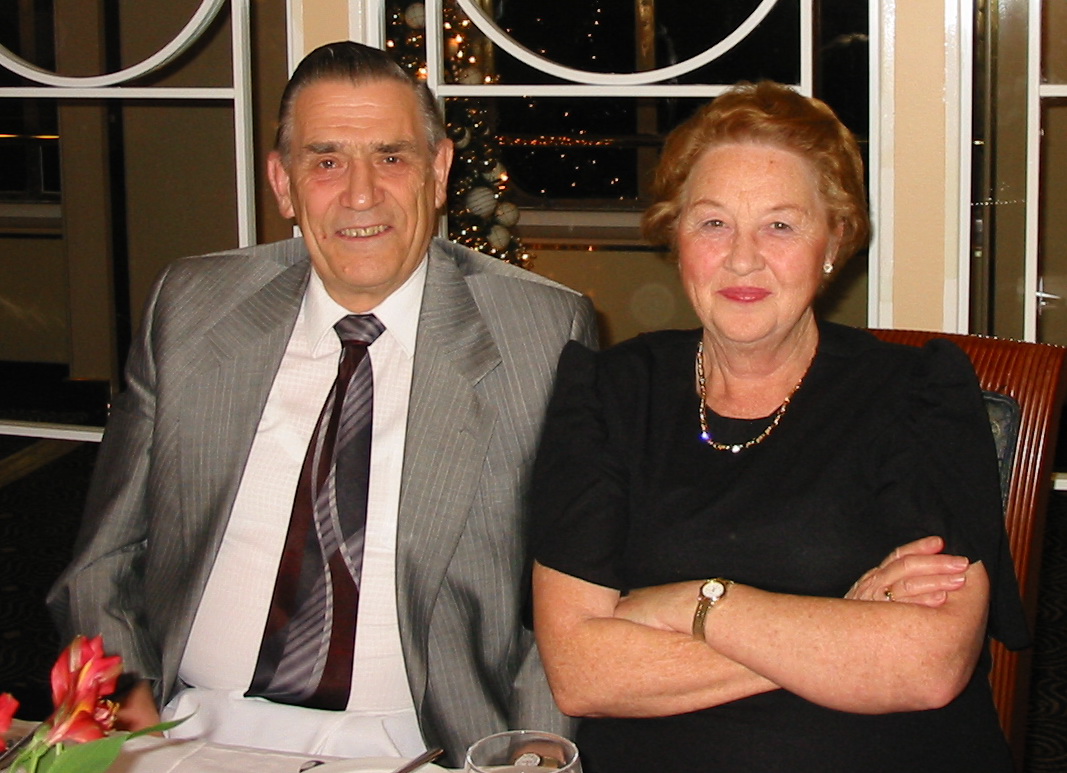
Walter C. Meyer graduated from the University of Alberta as a dentist in 1961. He taught in the Faculty of Dentistry beginning in 1963 and served from 1977 until his retirement in 1994 as professor and chairman of the Operative Division. He played in the Edmonton Symphony Orchestra as a cellist from 1957 to 1967, then as soloist and chamber musician in concerts, on radio, and on television for more than three decades. An accredited genealogist, he has served as president of the Edmonton Branch of the Alberta Genealogical Society and has written five books on genealogy for the use of his family. His Church service has included missionary in the Canadian Mission, bishop, stake extraction program director, family history centre director, and temple sealer. He and his wife, Gwen Payne, are parents of six children and have twenty-five grandchildren and nineteen great-grandchildren. (Walter C. Meyer)
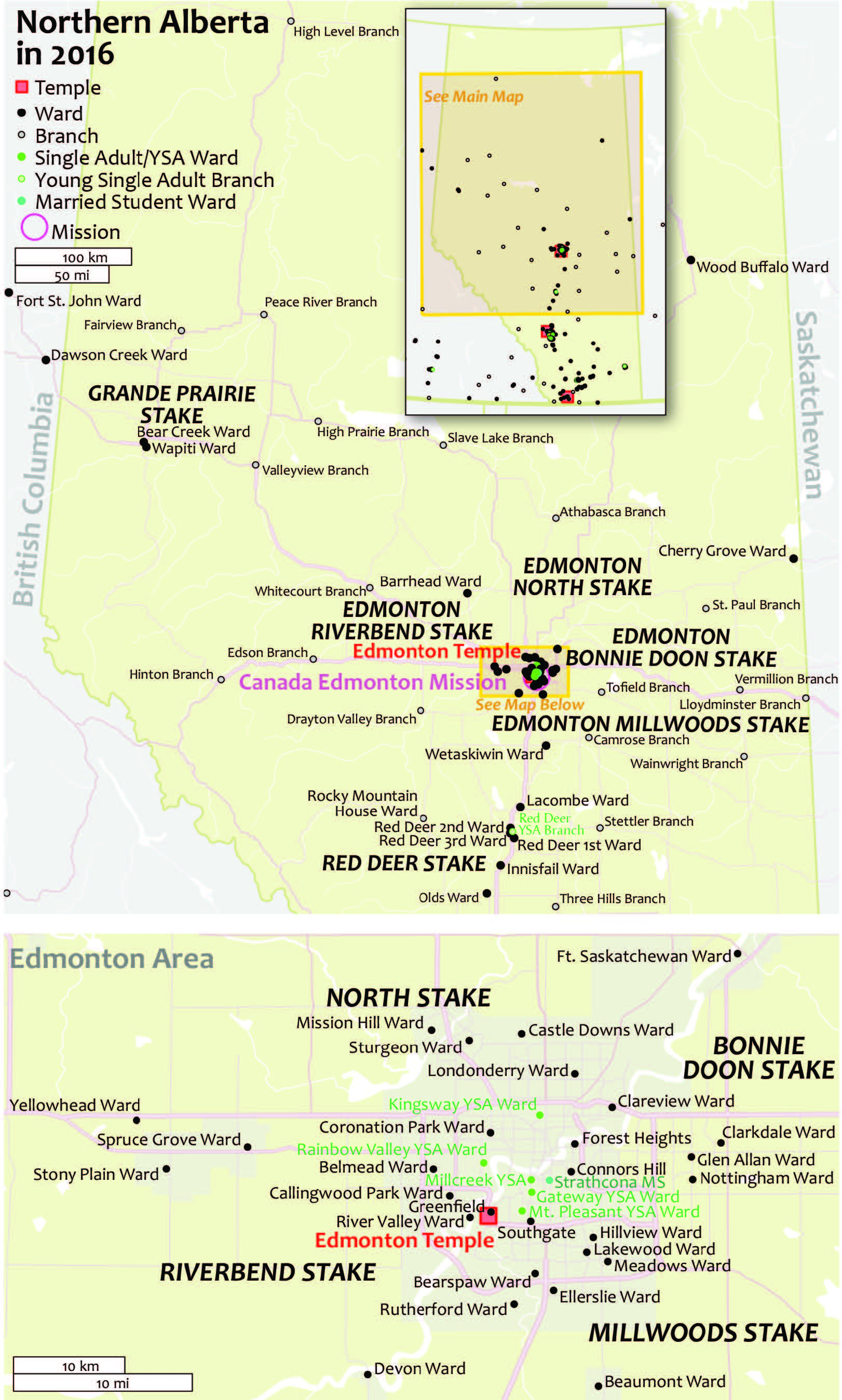 The growth of the Church in Edmonton and in the northern part of Alberta has been impressive. From the first official meetings in 1933, the Church has grown to include six stakes, with over twenty thousand members. The fulfillment of many dreams was realized with the dedication of the Edmonton Alberta Temple in 1999.
The growth of the Church in Edmonton and in the northern part of Alberta has been impressive. From the first official meetings in 1933, the Church has grown to include six stakes, with over twenty thousand members. The fulfillment of many dreams was realized with the dedication of the Edmonton Alberta Temple in 1999.
The Church of Jesus Christ of Latter-day Saints in Edmonton and northern Alberta has experienced considerable growth in a relatively short period of time. When the first small group of Latter-day Saints began meeting officially in Edmonton in early 1933, slightly more than a century had elapsed since the Church was organized in Fayette, New York. During the eight decades since that 1933 meeting, six stakes of Zion have been formed in the Edmonton area and the region north, and in 1999 the beautiful Edmonton Alberta Temple was dedicated. Hundreds of leaders at every level, a host of missionaries, and many thousands of members have been involved in this remarkable achievement. Their contributions, large and small, have provided a strong foundation for the Church in the northern part of the province. Most of the leaders and many of the members during much of this history did not come from Edmonton, however, but mostly migrated from southern Alberta for education, employment, or government service.
President Gordon B. Hinckley affirmed that without attending the temple, a person cannot receive the full blessings of the gospel. “The temple ordinances,” he said, “become the crowning blessings the Church has to offer.”[1] In this chapter on the history of the Church in Edmonton and northern Alberta, three main themes emerge: sustained growth in the face of numerous challenges; the power of a knowledgeable testimony of the restored gospel; and the blessings of temple worship. Despite the challenges of vast distances and very cold and sometimes unpredictable winter weather, the Church in Edmonton and other northern areas has flourished from very humble beginnings to become a centre of strength with more than twenty thousand members in 2015.
Gateway to the North
The vastness of Alberta, the fourth largest Canadian province, has posed challenges for members of the Church. Alberta contains 661,848 square kilometres, which is approximately the size of the state of Texas, the second largest in the United States. The distance by road from the north to the south of the province is about 1,500 kilometres, while the longest east–west road is more than 650 kilometres and the narrowest is about 360 kilometres.[2] Edmonton, although technically in the southern half of the province, is referred to as the “Gateway to the North.”
Founded as a Hudson’s Bay Company fur trading post in 1795, Edmonton has a long history which includes explorers, fur traders, gold seekers, and religious missionaries, both Catholic and Protestant. It was incorporated as a city in 1904 with a population of 8,350 and, when the Province of Alberta was created in 1905, was selected as the provincial capital.[3] In 2015 it was the fifth largest metropolitan area in Canada with 1.3 million inhabitants.[4] Edmonton has become the centre of one of the major economic regions of the country due to its location in a rich farming area; its important natural resources in the area and to the north, including vast oil deposits; and its geographic position as a transportation hub between the north–south and the east–west corridors of Canada. Additionally, Edmonton has had the economic advantage of being the provincial capital as well as claiming the University of Alberta, the province’s oldest university, dating from 1908.[5]
Because of the huge distances in the vast area of northern Alberta, filling Church responsibilities has often required much time, effort, and expense. Fort McMurray is located about 450 kilometres, or five hours driving time, from Edmonton. Local leaders in Fort McMurray and those in Cherry Grove and Lloydminster, also hundreds of kilometres away, have regularly attended once-a-month stake leadership meetings in Edmonton.[6] Stake presidency members in the widely spread out Grande Prairie Stake averaged 500 kilometres of driving each week on stake business, meaning that after a decade in office, they had driven approximately 250,000 kilometres, essentially the life of a car.[7] Driving time to the Cardston Alberta Temple from Edmonton, almost 600 kilometres straight south, was six to seven hours each way, and from Grande Prairie, close to 1,000 kilometres, ten to eleven hours.[8]
Another significant challenge in the Edmonton area and further north has been that of severe winter weather. The average low temperature in Edmonton in January is –19°C (–2°F).[9] Unexpected winter storms, sometimes with blizzard conditions, have made winter driving perilous. Many travelling in these northern areas routinely carry a snow shovel in case they go off the road and emergency winter clothing in case of mechanical or other difficulty.
Early Growth in the Red Deer Area, Northern Alberta, and Edmonton
Called as president of the Alberta Stake in 1903, Edward J. Wood travelled annually to visit the wards and branches of the stake. In July 1904, accompanied by stake and ward officers, Wood made a trip to visit scattered Church members in the north. The group travelled as far north as Lacombe and Rimbey, north of Red Deer, and held Church meetings there. A total of thirty-eight adults and children met in William C. Tolman’s home, near Rimbey, for services. This is the first known record of Church services in the northern part of Alberta. The next day, Wood was inspired to organize a branch in that area, calling Tolman to be the first branch president.[11]
Some of the migration of Latter-day Saint families and individuals to northern Alberta came as a result of the Federal Dominion Lands Act of 1872, which provided opportunity for homesteads. One such homesteading group emigrated from Iowa in 1907 to Leedale, Alberta, about 70 kilometres northwest of Red Deer. The group did not have contact with any official unit of the Church for thirty-five years, but they remained true to the faith and held a Sunday School until 1942, when missionaries from the Western Canadian Mission found the group of seventeen members.[12]
A notable pioneering expedition took place during the Great Depression when, in May and September 1933, two groups of Latter-day Saint families, totalling about sixty souls, migrated north from the Glenwood area to escape the drought conditions of southern Alberta. These hardy Saints travelled to Beaver Crossing, Alberta, about 280 kilometres northeast of Edmonton, to homestead in an area with reputedly more rainfall. Reminiscent of the pioneer trek to Utah, they journeyed in covered wagons across Alberta prairie land to Rosebud (110 kilometres northeast of Calgary), from whence they were moved by train to Bonnyville and then resumed their wagon journey for the final 55 kilometres to their destination. In September 1933, more than two years before the organization of the first branch in Edmonton, these Saints became the Beaver Crossing Branch, part of the North Central States Mission. In December 1942, the Beaver Crossing Branch (later renamed Cherry Grove), along with all Saskatchewan, was transferred to the Western Canadian Mission.[13]
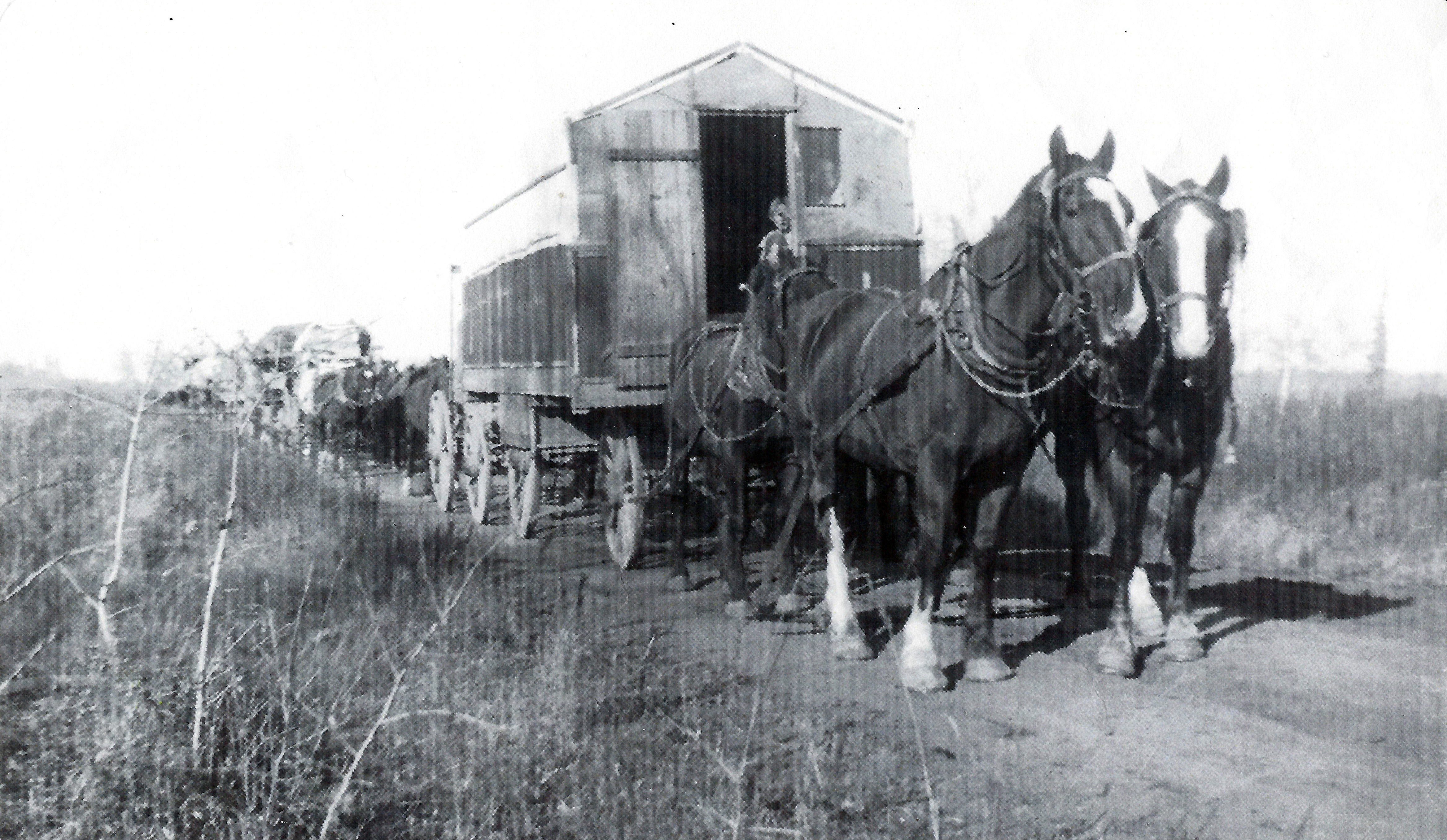 Horse-drawn wagon on the 1933 trek from Glenwood to Beaver Crossing (later Cherry Grove Branch). Pioneers in this wooded area lived in log cabins. When this family’s horses died of “swamp fever,” the family went to Church meetings by dogsled in winter. (Betty Margaret Burgess)
Horse-drawn wagon on the 1933 trek from Glenwood to Beaver Crossing (later Cherry Grove Branch). Pioneers in this wooded area lived in log cabins. When this family’s horses died of “swamp fever,” the family went to Church meetings by dogsled in winter. (Betty Margaret Burgess)
The First Branch in Edmonton
The first members who came to Edmonton in the early decades of the twentieth century came for a variety of reasons, but they did not stay permanently. John H. Blackmore, who later became the first Latter-day Saint elected to the Canadian House of Commons, was the first known Latter-day Saint student at the University of Alberta, attending from 1909 to 1913.[14] In 1914, Robert Gordon; his wife, Fannie; and their four children moved from Stirling to Edmonton so Robert could work as a land surveyor for the provincial government. They were the first known LDS family in Edmonton. However, they moved to Lethbridge after two years so their family could attend Church meetings and activities.[15] Lawrence Peterson and George Stringam, members of the Legislative Assembly first elected from southern Alberta in 1921, stayed in Edmonton hotels to attend sessions of the legislature.[16] John A. Widtsoe of the Quorum of the Twelve Apostles visited Edmonton for a week in 1925 at the request of the provincial premier to advise the government on irrigation. While in Edmonton, Widtsoe found that there were “very few” members of the Church in the city, although he “met some,” including Rhoda Low Rogers.[17]
The permanent establishment of the Church in Edmonton began in the 1930s. In 1930, students from southern Alberta—David Elton, Wayne Matkin, and Vi Wood— came to attend the University of Alberta, the only university in the province, and by 1933, the ranks of LDS students at the University of Alberta had increased to four or five.[18] In July 1932, the Alfred R. and Mabel Strate family moved to Edmonton from Glenwood.[19]
The first recorded meeting of Latter-day Saints in Edmonton took place on 26 February 1933 in the home of Alfred and Mabel Strate, with a handful of families and students. Vi Wood kept minutes of that first meeting, attended by fifteen members and two nonmembers. The group had not yet received authorization to serve the sacrament, but this was granted at a later date. In addition to the Strate family, the small group included, among others, a married student, Glen E. Nielson, later founder of Husky Oil; his wife, Olive (daughter of Edward J. Wood); and other students, Briant W. Stringam, Wallace Hansen, Vi A. Wood, and Elmo Fletcher.[20] Fletcher later became president of the Lethbridge Stake, and both Fletcher and Wood later served as presidents of the Cardston Alberta Temple.[21]
While the little group discontinued meetings in the summer of 1933 when the students went home, it resumed meetings when they returned in the fall and met continually thereafter.[22] In November 1935, the Edmonton group became a dependent branch of the Calgary Ward with Alfred Strate as presiding elder and with Grant Woolley (later to be president of the Lethbridge Stake) and Clarence Strate as counselors. The branch began holding meetings in Scona Hall, at Whyte Avenue and 103rd Street.[23]
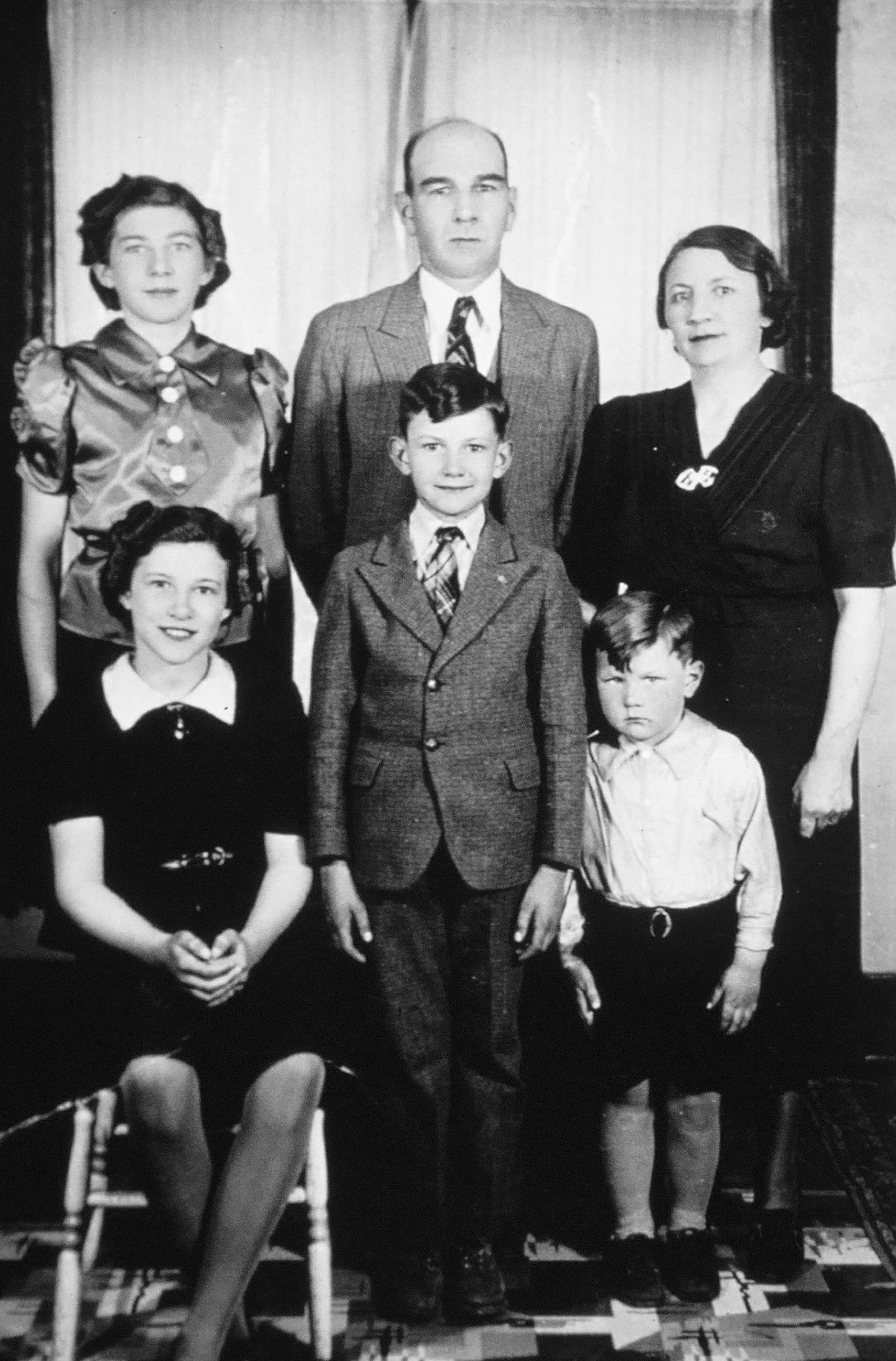 Clarence and Esther Strate and their family were early members of the Edmonton Branch, arriving in August 1934. Clarence was the older brother of Alfred Strate, the first branch president. Gordon, the youngest child in the photograph, was the first Latter-day Saint child born in Edmonton and later played hockey for the Detroit Red Wings in the National Hockey League. (Edmonton Bonnie Doon Stake)
Clarence and Esther Strate and their family were early members of the Edmonton Branch, arriving in August 1934. Clarence was the older brother of Alfred Strate, the first branch president. Gordon, the youngest child in the photograph, was the first Latter-day Saint child born in Edmonton and later played hockey for the Detroit Red Wings in the National Hockey League. (Edmonton Bonnie Doon Stake)
The election of a Social Credit government in Alberta in 1935 brought four Latter-day Saints from southern Alberta to the provincial legislative assembly in Edmonton—Nathan Eldon Tanner, Solon Low, Hans E. Wight, and James Hansen.[24] For the 1936 sessions of the Assembly, they only remained there for the two to three months while the legislature was in session. Tanner and Low moved their families to Edmonton in 1937 when they were appointed to cabinet posts requiring their full-time attention.[25] N. E. Tanner served as Speaker of the Legislative Assembly in 1936, and in 1937 he was appointed Minister of Lands and Mines, which in 1949 became two ministries, with Tanner holding both portfolios. Solon Low was appointed in 1937 as provincial treasurer. Both men, stalwarts in the Church, served with distinction in the provincial legislature and later went on to other responsibilities—Tanner as the first president of TransCanada Pipelines and Low as national leader of the Social Credit Party.[26] The addition of the Low and Tanner families was a significant increase to the membership of the Edmonton Branch.
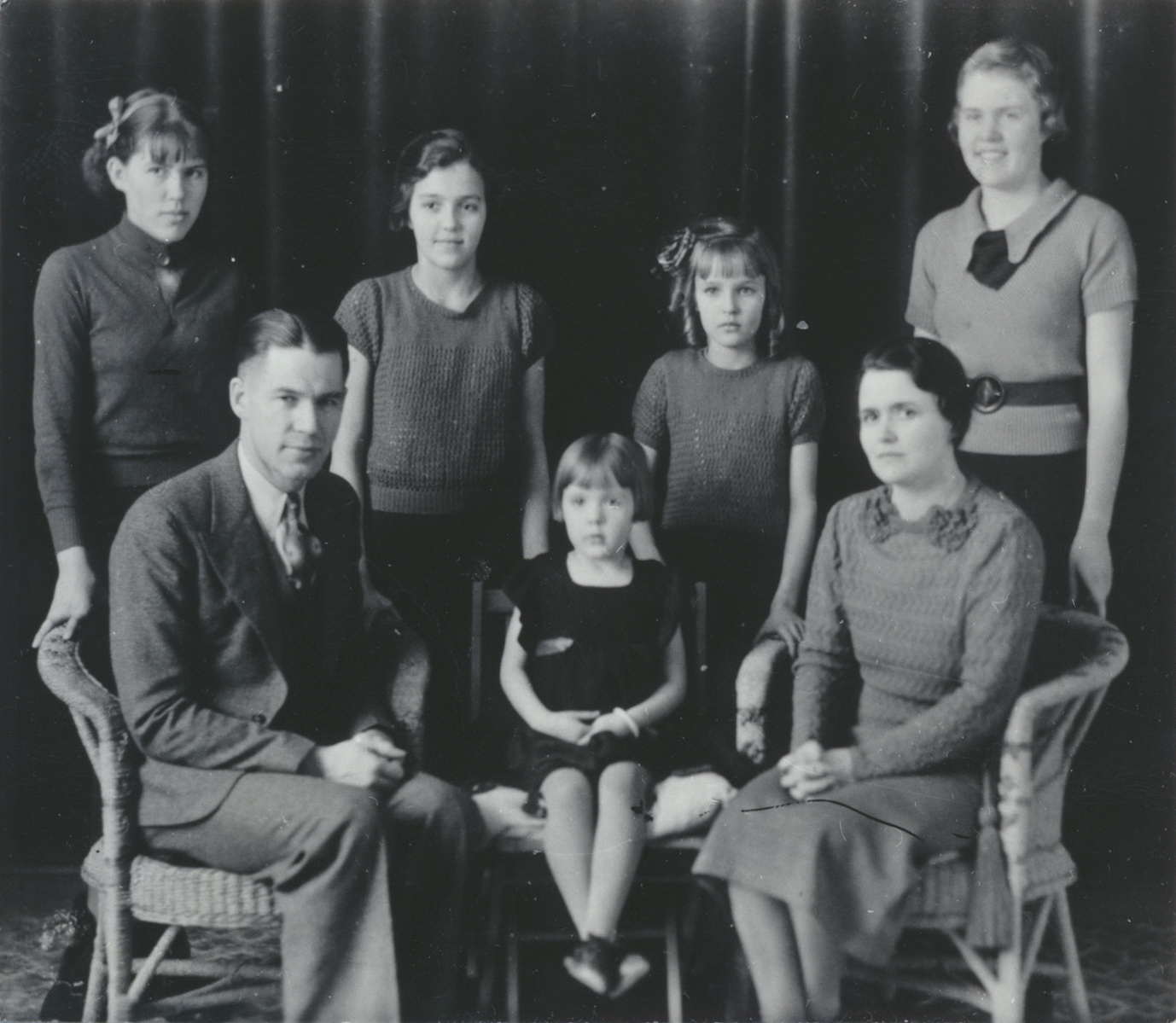 N. Eldon and Sara Tanner with their five daughters. This photograph was taken about 1935, before the family moved to Edmonton. (Thomas E. Walker)
N. Eldon and Sara Tanner with their five daughters. This photograph was taken about 1935, before the family moved to Edmonton. (Thomas E. Walker)
On 1 July 1938, the Edmonton Branch became an independent branch in the Lethbridge Stake.[27] The membership records of sixty-one, including unbaptized children, were transferred from the Calgary Ward to the now independent Edmonton Branch.[28] Auxiliaries were first organized in the branch on 9 October 1938, with Sara Tanner as Relief Society president, Alice Low as Young Women’s MIA president, William Sykes as Young Men’s MIA superintendent, and Mary Ella Hancock as Primary president.[29] The branch met in various rented halls during those years, some of which required the removal of beer bottles and cigarette butts before meetings could be held. In 1942, the branch began meeting in the Independent Order of Odd Fellows (IOOF) hall on 95th Street and 112th Avenue, where it met until the Whyte Avenue meetinghouse was built following the Second World War.[30]
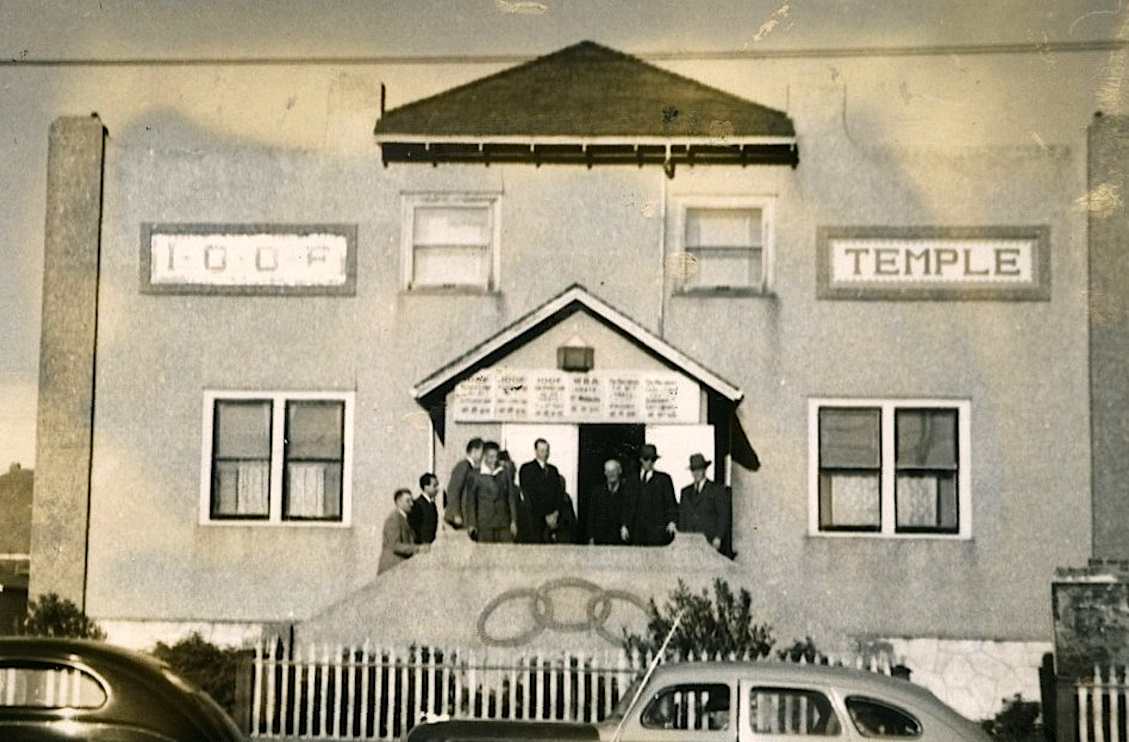 The Edmonton Branch held meetings in the IOOF Hall on 95th Street and 112th Avenue from 1942 until 1951. This photo was likely taken in the 1940s. (Edmonton Bonnie Doon Stake)
The Edmonton Branch held meetings in the IOOF Hall on 95th Street and 112th Avenue from 1942 until 1951. This photo was likely taken in the 1940s. (Edmonton Bonnie Doon Stake)
The Western Canadian Mission
As early as 1935, Asael E. Palmer, president of the Lethbridge Stake, expressed concern to President Heber J. Grant that the Lethbridge Stake was unable to adequately serve and support Church members in Edmonton, more than 300 miles (480 kilometres) away, and that the Edmonton Saints would best be served by a mission.[31] In June 1940, Palmer reported to the First Presidency that there was a thriving branch of 124 in Edmonton but that the branch was isolated, being 200 miles (300 kilometres) from the nearest ward in Calgary. The city of Edmonton was growing, and there was much potential for missionary work. Palmer strongly recommended the establishment of a Western Canadian Mission, which N. Eldon Tanner, president of the Edmonton Branch, firmly supported.[32] This recommendation was endorsed in a report of the stake presidents of the Lethbridge, Alberta, and Taylor stakes, who had been appointed to investigate the possibilities of successful missionary labour in Alberta.[33]
In April 1941, Walter Miller from Taber, Alberta, a recently returned missionary, reported on his mission to Apostle George Albert Smith at Church headquarters in Salt Lake City. Elder Smith asked for his thoughts about the Church establishing a mission in Western Canada. Miller responded, “Brother Smith, I think it an excellent idea!”[34] In July 1941, the same Walter Miller, just thirty years old and still unmarried, received a call from the First Presidency to preside over the Western Canadian Mission, the thirty-seventh mission of the Church. Miller put his affairs in order, was set apart by Stephen L. Richards of the Quorum of the Twelve on 5 September 1941, and five days later, as the youngest of all existing mission presidents, moved to Edmonton for four years.[35]
The first mission home at 9734–106 Street was leased for $47.50 a month. Miller and two or three missionaries “batched” there until October 1942. At that point, the bachelor president returned from general conference with his new wife, Afton Ingersoll Miller, who was from American Fork, Utah, and whom he had first met in 1939 while he was on his way to the British Mission. She had been an employee of the Presiding Bishop’s Office, and during lunch she cashiered at the Lion House cafeteria. They were united in marriage in the Salt Lake Temple on 5 October 1942.[36]
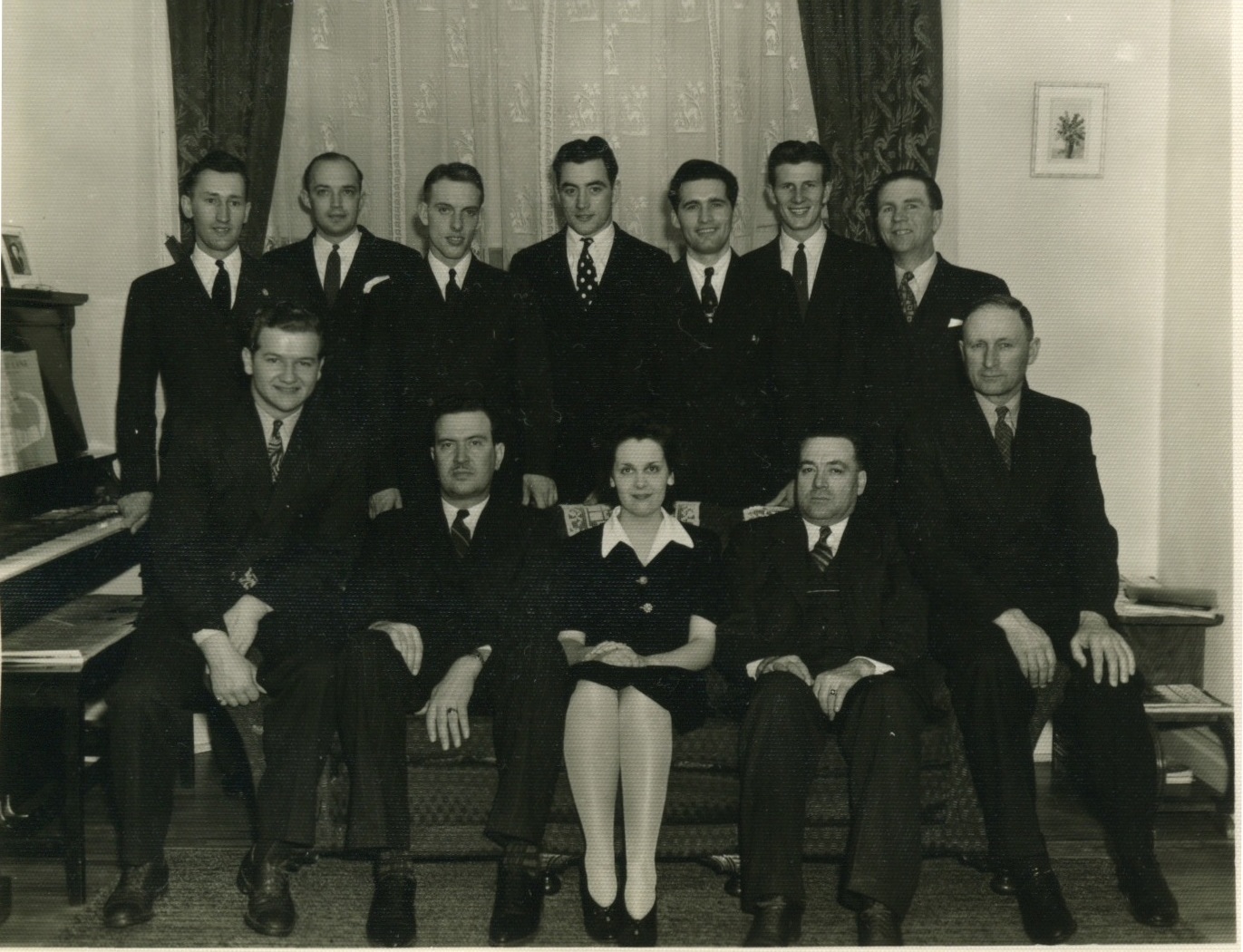 Walter Miller, seated center beside his wife, Afton, and a small group of missionaries. Miller was the first president of the Western Canadian Mission. This photograph was taken between 1942 and 1944. (Edmonton Bonnie Doon Stake)
Walter Miller, seated center beside his wife, Afton, and a small group of missionaries. Miller was the first president of the Western Canadian Mission. This photograph was taken between 1942 and 1944. (Edmonton Bonnie Doon Stake)
The missionary force provided to Miller in September 1941 consisted of six “seasoned missionaries” transferred from the North Central States and Northwestern States Missions. Unfortunately, they were all scheduled soon to complete their two-year terms, and only a small number were being sent to replace them and build the missionary force due to wartime conditions (see chart below).[37] A few short-term missionaries were called from southern Alberta, beginning in December 1941, to supplement the full-time missionary force.[38]
The Western Canadian Mission originally covered “all territory north of the city of Calgary” but did not include Saskatchewan and British Columbia, which were added later.[39] Between 1941 and 1998, when the Canada Edmonton Mission was created, there were many name and boundary changes, as summarized below:
At its largest, in the 1950s, the Western Canadian Mission, besides including the three western provinces, extended north through the Northwest and Yukon Territories as far as there was land—covering an area almost one and a half times larger than the western section of the United States if the line were drawn between Texas and the Dakotas.[45]
The Edmonton missionary district was formed in September 1941, and missionary work expanded to Olds, Red Deer, Camrose, Wetaskiwin, Lloydminster, and Drumheller by the end of that year. The first convert was baptized in Edmonton in December 1941.[46] In 1942, missionaries also laboured in Calgary, Edson, Grande Prairie, Leedale, Ponoka, Rosedale, Stettler, Vegreville, Vermilion, Medicine Hat, High River, and Wainwright, as well as began work in Saskatchewan; new missionary districts were also created in Calgary and Peace River.[47] The Edmonton Branch remained a part of the Lethbridge Stake until November 1942, when it was officially transferred to the Western Canadian Mission.[48]
Joseph Y. Card, son of Charles Ora Card, became the second president of the Western Canadian Mission at the release of Walter Miller in 1945. Glen G. Fisher, a former bishop from Hill Spring, Alberta, served as mission president from 1947 to 1951.[51] The Second World War was over when President Fisher took the reins, which meant an increase in available young men to serve missions, causing a period of great expansion in the mission, with a dramatic increase in convert baptisms.[52]
The Edmonton Branch: The N. Eldon Tanner Years
The first conference of the Edmonton Branch was held 19 March 1939.[54] Lethbridge Stake President Asael E. Palmer presided, and during the meeting N. Eldon Tanner, who had previously served as bishop of a Cardston ward, was appointed branch president. His counselors were Arthur McMullin and Ernest Poulson.[55] Under Tanner’s leadership, the Edmonton Branch prospered with the application of the full Church program, including the establishment of a standard budget, building fund, and welfare program. Branch missionaries were now set apart, and home teachers emphasized reactivation and the importance of temple participation. [56]
N. Eldon Tanner, known in government circles as a man of great integrity,[57] was almost idolized by the branch members during his tenure as branch president, especially by his associates and by the youth. He expected a high level of performance and encouraged people to have confidence in themselves to become who the Lord wanted them to become, and they responded with enthusiasm. He led by example and in his words and actions showed people how to be true Latter-day Saints. He practiced love and charity for those who had less of this world’s goods than he, giving anonymous gifts of food, home furnishings, or needed items. Perhaps in part because of his later role in the leading councils of the Church, especially in the First Presidency, his legacy continues to have a powerful influence in Edmonton.[58]
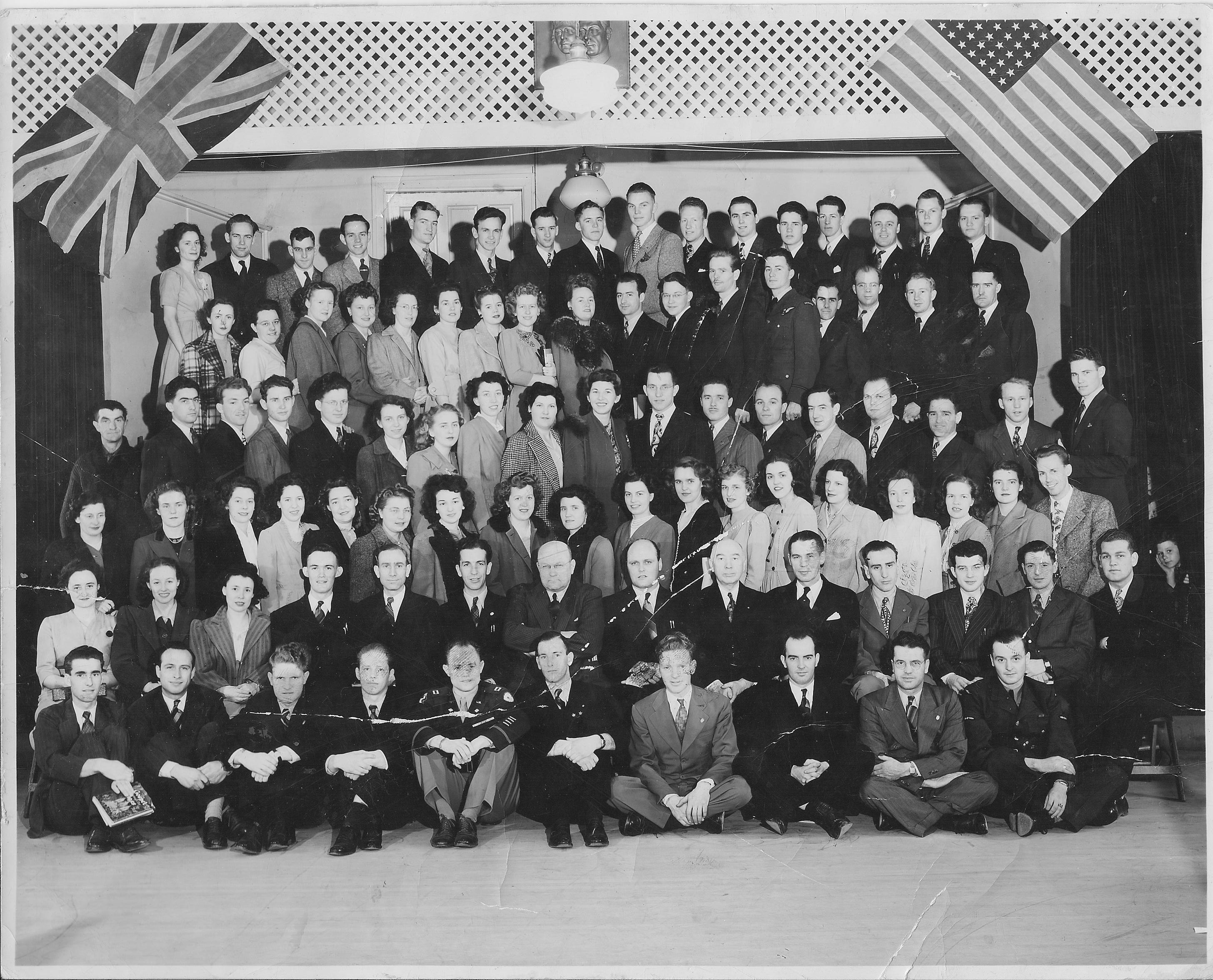 The Edmonton Branch adult Sunday School class, May 1946, at the IOOF Hall. J. Y. Card, mission president, and N. E. Tanner, branch president, are seated on row 2, the ninth and tenth from the left. (Thomas E. Walker)
The Edmonton Branch adult Sunday School class, May 1946, at the IOOF Hall. J. Y. Card, mission president, and N. E. Tanner, branch president, are seated on row 2, the ninth and tenth from the left. (Thomas E. Walker)
Joseph F. Merrill of the Quorum of the Twelve, the first Apostle to visit Edmonton on Church assignment, attended a special meeting of the branch on Tuesday, 25 February 1941. He was accompanied by Octave W. Ursenbach of the Lethbridge stake presidency. Reflecting the musical emphasis of the branch, the meeting featured two vocal solos, one violin solo, and two numbers by the branch choir. The visiting Church leaders instructed the members on gospel principles and encouraged them to support the war effort by purchasing war bonds.[59]
The War Years and After
The growth of the Edmonton Branch during its first decade was significantly influenced by World War II. Because of Edmonton’s relationship to the north and the building of the Alaska Highway—as a result of concern about a Japanese invasion through Alaska—many military personnel from many countries enlarged the branch. In these early years, there were some convert baptisms, but migration for employment, especially with the military and government, was the largest factor in branch growth.[60] Most migrating Church members came from southern Alberta and included many of the Edmonton “pioneer” families—Morgan and Fay Pitcher, Low (Al and Regina, Bruce and Ruth), Harry and Golda Kincade, Robert and Ethel Stockdale, Kay and Marie Burnham, John and Emma Sheppard, Harold and Dora Bennett, and others.[61]
During the war years, while the city of Edmonton grew at an accelerated rate, the Church grew even faster. In 1940, Church membership in the Edmonton Branch stood at 129 and by 1945, at war’s end, branch membership had increased to 237,[62] nearly doubling, while city population in the same period had grown from 90,000 to 112,000, just under 25 percent.[63]
The trend continued in the postwar period of prosperity. By 1949, branch membership had risen to 488,[64] again outstripping the growth rate of the city, which had increased to 137,000.[65] In 1947, with the gushing of oil from the famous wildcat well Leduc No. 1, some fifteen kilometres west of the city, Edmonton became the “Oil Capital of Alberta,” and the economic boom which followed attracted many people. Church growth was also fueled by an increase of LDS university students and an increase in convert baptisms.[66]
Building the Whyte Avenue Chapel
Church members in Edmonton, having met for years in rented halls, greatly desired to have a meetinghouse of their own, but at that time, local members were required to donate a significant portion of the funds or labour for building construction. Fund-raising activities occupied much time and effort. Over a period of many years, branch members raised building funds through donations and projects, such as bazaars put on by the Relief Society, exhibition booths, and the annual chocolate project. In 1948, the branch sponsored the production of a Gilbert and Sullivan operetta as a fund-raiser, which netted three thousand dollars. As branch members sacrificed and worked diligently together, they developed “a remarkable spirit of love and harmony.”[67]
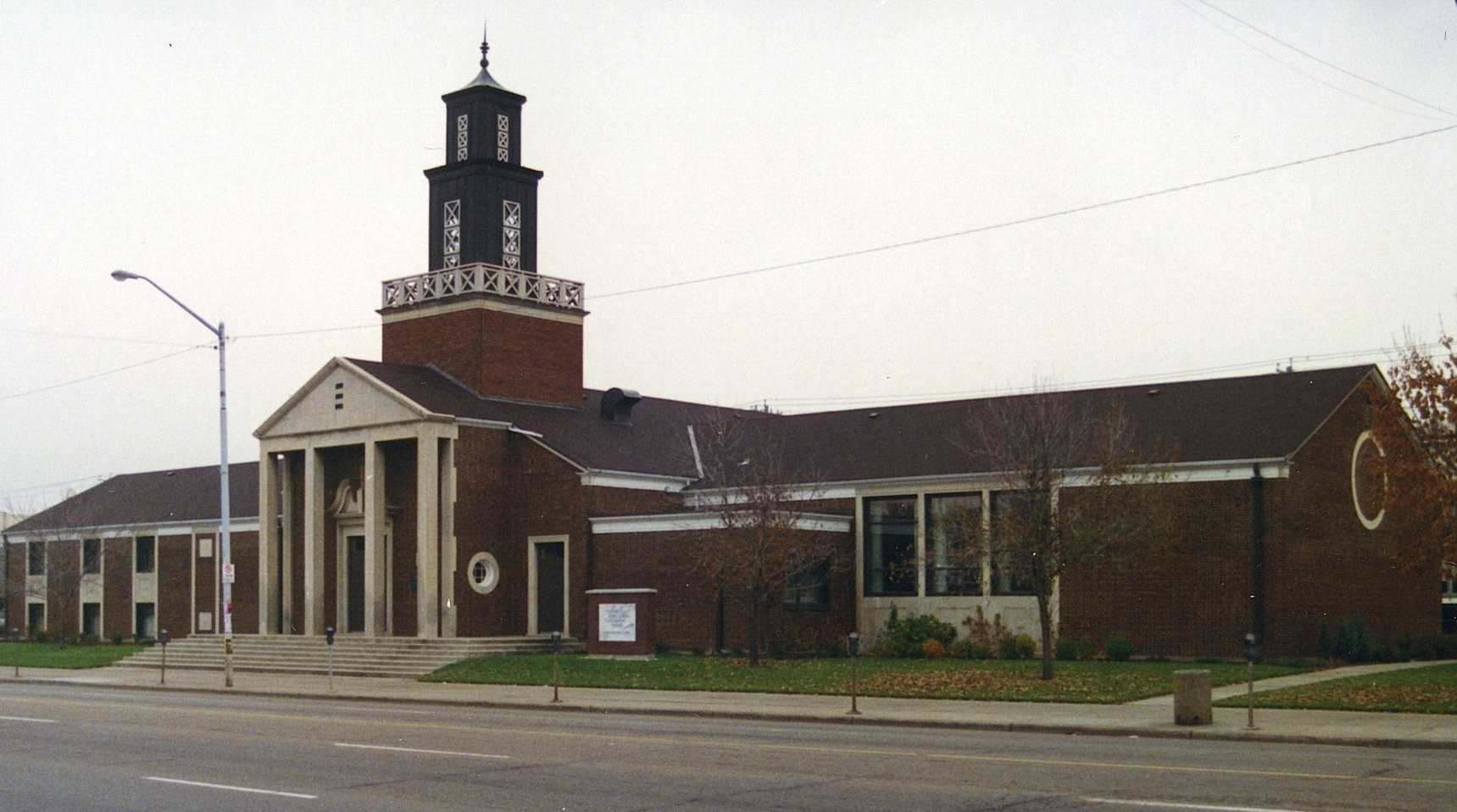 The Whyte Avenue building, the first LDS meetinghouse in Edmonton, was completed in 1951 under the leadership of N. E. Tanner, branch president. (Edmonton Bonnie Doon Stake)
The Whyte Avenue building, the first LDS meetinghouse in Edmonton, was completed in 1951 under the leadership of N. E. Tanner, branch president. (Edmonton Bonnie Doon Stake)
Progress of the building was delayed due to the war. Although the site at 82nd Avenue and 108th Street was purchased in 1944, the wartime shortage of building materials delayed the granting of a building permit.[68] In May 1949, after many months of correspondence between branch leaders and the Church Building Department, the Church Expenditure Committee in Salt Lake City gave permission to proceed. N. Eldon Tanner turned the first sod on 6 June 1949.[69] Much of the construction was done by local members, some of whom recalled feeling heat through their leather gloves as they transported newly made bricks from a brick kiln onto a member’s truck and to the work site.[70] The first baptismal service in the uncompleted building, with visitors seated on planks that rested on sawhorses, took place on 23 April 1950, and the first worship service was held in the cultural hall on 3 September 1950, where the branch continued to meet until the chapel was completed.[71] “The patience, faith, and prayers of the little band of Saints was at last rewarded” when the dedication of the Edmonton chapel took place 5 August 1951, with the offering of the dedicatory prayer by Stephen L. Richards of the First Presidency.[72]
In 1952, N. Eldon Tanner resigned from government service and moved to Calgary to work in the petroleum industry, thus ending his tenure of thirteen years as president of the Edmonton Branch.[73] He left it strong, vibrant, and enthusiastic—still young and ready to grow to the next stage of stakehood.
Institute of Religion
The route from southern Alberta to Edmonton was sometimes called the “Sheepskin Trail,” as students migrated northward to what, at that time, was the only university in the province. Although there were a few Latter-day Saint students at the University of Alberta in earlier years, from 1930 onward there has been a continuous presence and increase of LDS students in Edmonton.[75]
In the 1940s, Latter-day Saint students in Edmonton formed an LDS club in order to participate in an intramural basketball league. In addition to providing sports involvement, the club’s constitution called for regular meetings. During those meetings, held in the medical building on campus, Brigham Card, an LDS faculty member, led gospel discussions, and the students socialized with one another.[76]
It was evident to Joseph Y. Card, mission president (1945–47); his successor, Glen G. Fisher (1947–51); and to N. Eldon Tanner that an institute of religion in Edmonton would be very beneficial to the LDS university students. They promoted the idea with visiting General Authorities and annually recommended the construction of an institute building to the First Presidency.[77] Tanner affirmed that “the Institute would be second only to the temple in its influence upon the lives of the young people.”[78]
Church Authorities were doubtful that there would be sufficient enrollment in Edmonton to warrant construction of an institute building, but local leaders were undaunted. Glen G. Fisher enthusiastically promoted the idea with General Authorities, and Tanner submitted surveys, charts, and maps to support the proposal. Eventually, they convinced Church leaders of the viability of the idea. On 14 October 1949, land was acquired for the construction of an institute building at the corner of 116th Street and 87th Avenue, on the southwest perimeter of the campus.[79] The building was constructed during 1952, and Paul E. Felt was appointed the first institute director. The first institute class convened on 9 October 1952 in the uncompleted building “amid the noise of hammer and saw.” Classes in Old Testament, courtship and marriage, Book of Mormon, and Mormon doctrine and philosophy were held in the early mornings, at noon, and in the evenings.[80]
On 14 October 1953, Harold B. Lee of the Quorum of the Twelve dedicated the Edmonton Institute of Religion, the first institute building constructed outside the United States.[81] The first institute graduation took place on 28 March 1954.[82]
Institute Growth
The following chart shows institute attendance (so far as numbers are available) for some early years:[83]
The institute was an instant success. An April 1956 statistical report revealed that, of the 182 Latter-day Saint students enrolled at the University of Alberta during the previous four years, 171 were active in the Church. Fourteen convert baptisms had been made at the institute, and 42 institute students had served missions, were currently serving, or were soon to depart on missions. There had been 43 temple marriages, and 28 of those couples had met at the institute.[84] That the institute largely served the southern Alberta community initially, however, is evident from the fact that in 1956, only 7 of the 71 enrolled were from Edmonton.[85]
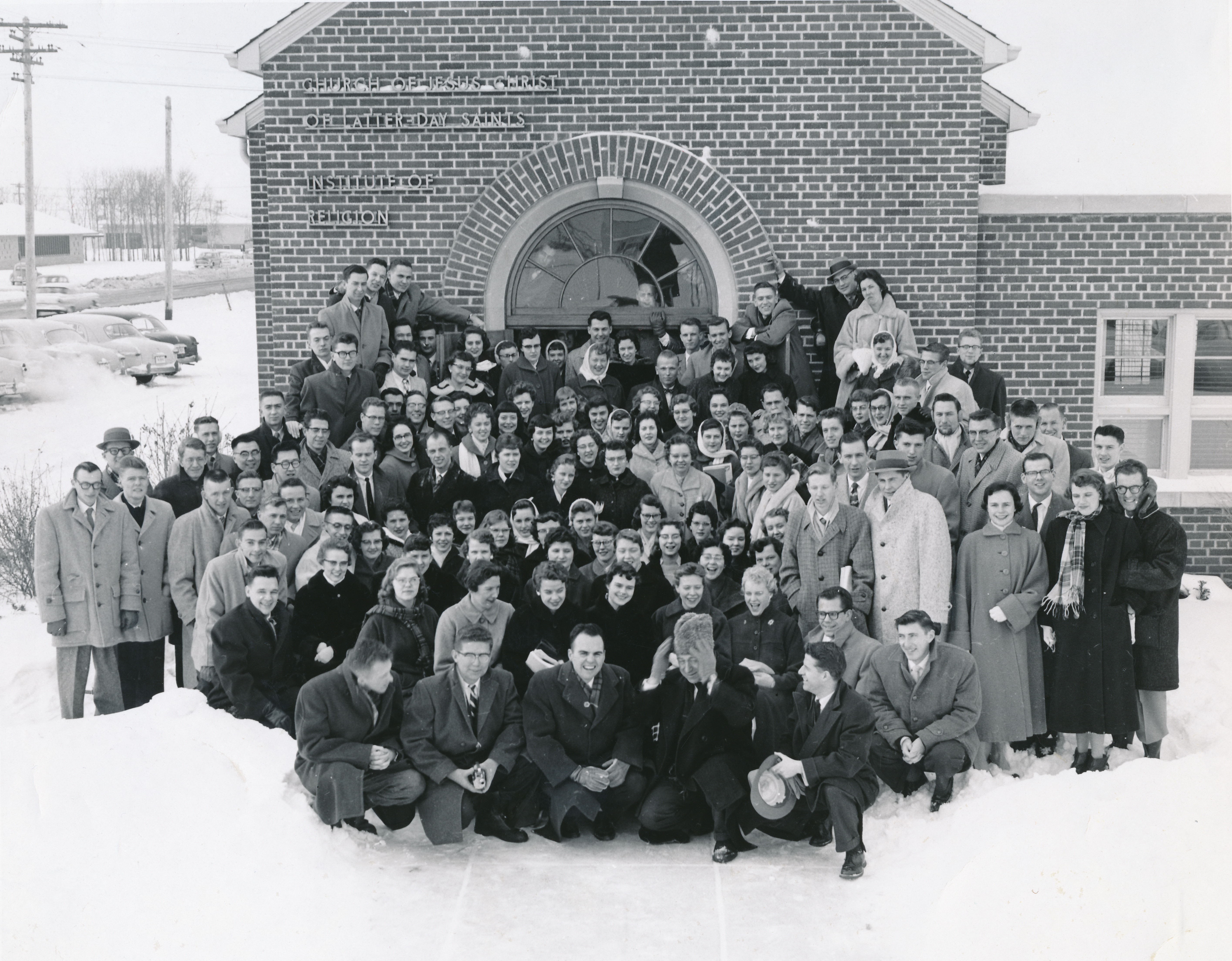 This photograph was taken during the winter of 1957–58 in front of the institute building, on 100 percent Sunday, which was the day targeted to have every institute member in attendance. Many future Church leaders, including four temple presidents, are in the group. (Jack Chalmers)
This photograph was taken during the winter of 1957–58 in front of the institute building, on 100 percent Sunday, which was the day targeted to have every institute member in attendance. Many future Church leaders, including four temple presidents, are in the group. (Jack Chalmers)
The first four institute directors, Paul Felt, H. Bartley Heiner, Monte Nyman, and Claire Judy, came from the United States. They were followed by a series of Canadian directors, including Phyllip Redd, Dale LeBaron, Jack Stone, and Ron Patrick, who all served with a number of full-time and part-time instructors.[86]
Although Church services had always been held at the institute building, the students were officially organized as an independent branch on 20 September 1959, with the institute director, Monte Nyman, as branch president.[87] When the Edmonton Stake was created in 1960, the student branch became a ward, with Malcolm Asplund as bishop.[88] In 1986 the original institute building was replaced with a new two-story structure dedicated on 29 November 1987 by Philip Sonntag of the Seventy, a former missionary in the Western Canadian Mission.[89]
The institute had a powerful impact on the lives of LDS young people. From 1983 to 2012, a total of over 21,000 institute students were enrolled, of which 7,690 were not college students, and 324—representing the missionary aspect of the institute—were not Church members. These statistics reflect the success of the institute in achieving the Church Educational System objective to have every Latter-day Saint university student also enrolled in a course of religion.[90] Schooled in gospel principles at the institute, educated LDS professionals—teachers, accountants, physicians, dentists, pharmacists, lawyers, agriculturists, engineers, and many other occupations—have been a great boon not only to the Church but to the province, the country, and even the world. Among the professions, dentistry seems to have held a particular attraction for Latter-day Saints, perhaps because of the lifestyle associated with the practice of dentistry. A study of University of Alberta dental graduates from 1954 to 1994 showed that Latter-day Saints represented more than 5 percent of those graduating, more than twice the percentage of the LDS population in Alberta.[91]
The numbers of University of Alberta students from southern Alberta continued to increase until colleges and universities were established in southern locations, mostly in the mid-1960s, helping students to obtain their education closer to home. The institute and university ward, however, soon became a magnet for LDS young people from many other locations across the country and continues to be so.[92]
The Edmonton District
In 1953, Heber Jensen was called as the president of the newly formed Edmonton member district, with counselors Harold Bennett and Kay Wood.[93] As president of the district, Jensen’s function was similar to that of a stake president, establishing and overseeing a full slate of district officers and travelling to the various branches to give guidance and training.[94] The district included not only branches in Edmonton but also those in a wide radius from Lloydminster on the east to Hinton and Edson on the west.[95]
Heber Jensen was rich in leadership experience. He had served in bishoprics and a stake presidency and as the first bishop of the Calgary Second Ward before his call as president of the Edmonton Branch in 1952, replacing N. Eldon Tanner.[96] Jensen and Tanner were in fact born the same year (1898); lived on adjacent farms in Aetna, Alberta; and grew up together as close friends and kindred spirits. Jensen’s “understanding of the gospel, his ability to teach, his great spiritual strength, wisdom and his inspired leadership qualified him for this great work.”[97] When Jensen was released as president of the Edmonton Branch in 1953, a second branch was formed in Edmonton, with Arthur McMullin and Morgan Pitcher as presidents of the first and second branches, respectively.[98]
On 10 May 1959, after a period of substantial growth, the two Edmonton branches were divided into four.[99] All four branches held all their meetings, tightly scheduled, in the Whyte Avenue meetinghouse. The building was scheduled all day on Sunday and each day of the week from Tuesday through Saturday. Despite the challenge of crowding, Church members experienced a strong feeling of unity and goodwill.[100]
Growth in Red Deer
While growth in Edmonton was increasing, Church membership in other areas of northern Alberta was growing as well. The first Church members in the Red Deer area were the Ervin and Mary Ellen Tolley family, who moved from Mountain View, Alberta, to Red Deer in 1939 when Ervin Tolley was stationed there with the army.[101] In the spring of 1941, the Tolley family taught the gospel to twin sisters Dorlene and Donabelle Blades, and that fall missionaries from the newly formed mission opened the area. The Blades sisters became the first converts in Red Deer in September 1945.[102]
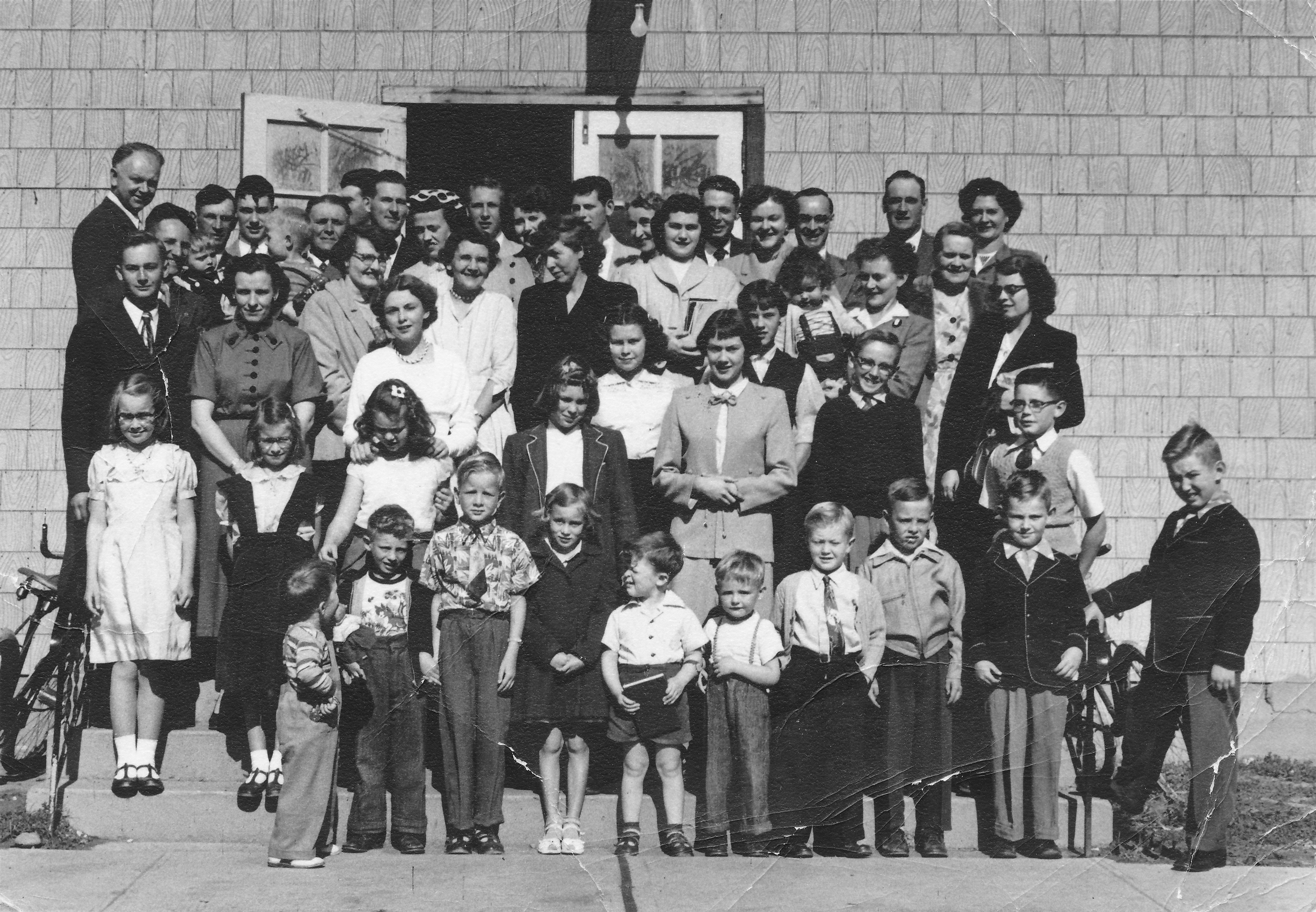 Members of the Red Deer Branch in 1953. The Red Deer Branch became part of the Calgary Stake when it was formed in 1953 but was transferred to the Edmonton Stake when it was created in 1960. (Red Deer Stake)
Members of the Red Deer Branch in 1953. The Red Deer Branch became part of the Calgary Stake when it was formed in 1953 but was transferred to the Edmonton Stake when it was created in 1960. (Red Deer Stake)
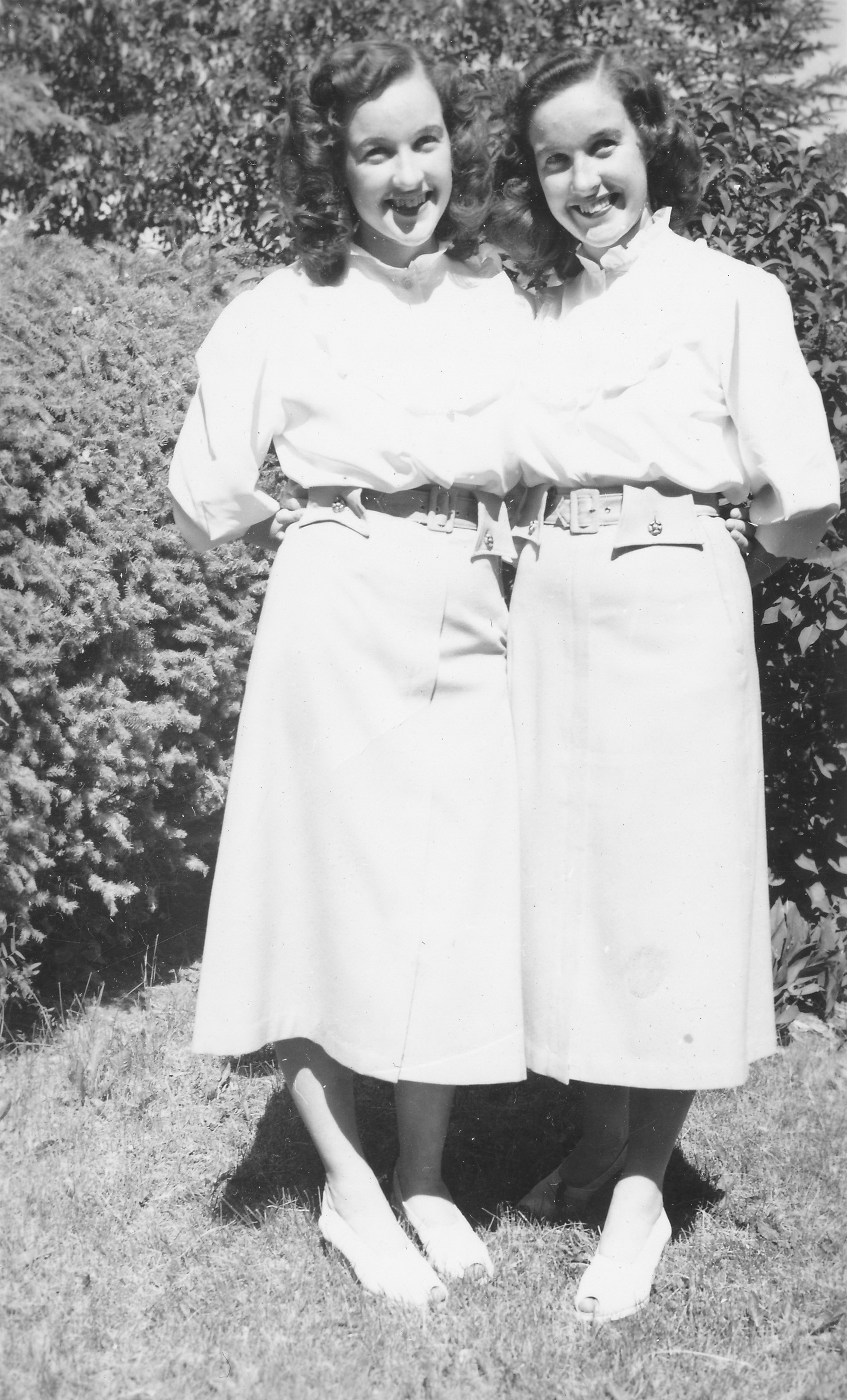 Twin sisters Dorlene and Donabelle Blades, Red Deer’s first converts, were baptized in 1945. (Red Deer Stake)
Twin sisters Dorlene and Donabelle Blades, Red Deer’s first converts, were baptized in 1945. (Red Deer Stake)
On 11 November 1951, the Red Deer Sunday School, which was first created in 1942,[103] became a branch, with 85 members. In 1953, along with other units in the area, the Red Deer Branch became part of the newly created Calgary Stake. But seven years later, in November 1960, the Red Deer Branch, which had then grown to 156 members, once again was grouped with the Saints in Edmonton, becoming part of the Edmonton Stake. That same month, the branch began meeting in its newly constructed meetinghouse.[104] The Red Deer Ward was created 16 April 1961, with Stanley N. Swainson as bishop and John Mitchel and Arthur Lacey as counselors. Following the successful retirement of a loan from the Church Building Department, the Red Deer meetinghouse was dedicated on 2 August 1964 by N. Eldon Tanner of the First Presidency.[105]
Like most meetinghouses in smaller branches, the Red Deer meetinghouse was built in phases, and the first two-phase structure was dedicated in 1964. Additional phases were added later. (Walter C. Meyer)
Creation of the Edmonton Stake
In November 1960, Richard L. Evans of the Quorum of the Twelve Apostles and N. Eldon Tanner, then an Assistant to the Twelve, travelled to Edmonton with the assignment to create a stake there.[106] On Tuesday, 15 November 1960, only eight years after Tanner was president of the Edmonton Branch, the “very inspirational and important” meeting that created the Edmonton Stake was held in the Whyte Avenue building.[107] It was the 312th stake in a Church of two million members.[108] Leroy Rollins was called as stake president, with Arthur M. McMullin and Mark L. Spencer as counselors.[109] Heber Jensen, who had been the district president since 1953, became the patriarch of the new stake. The four Edmonton branches and the Institute Branch became four family wards and the University Ward. These five wards in Edmonton were joined by the Red Deer Branch, which was transferred from the Calgary Stake.[110]
Remarkable Church growth that had taken place in the preceding decade was reflected in the fact that there were 2,126 members in the new stake.[111] The rate of growth of Church membership far exceeded that of the city, which had grown rapidly from 148,000 to 269,000.[112] Many Church members had come from southern Alberta. The patriarch, all members of the stake presidency and high council, all clerks, all bishops, and all but one bishop’s counselor had moved to Edmonton from elsewhere, and all but two of these had moved from the stakes in southern Alberta.[113]
Leroy Rollins, the new stake president, was relatively new to Edmonton, having come from Cardston two years earlier to establish a chain of grocery stores. He was also relatively inexperienced in Church administration, having served mainly in the Young Men organization. As he sought the Lord’s guidance for his new calling, he had a remarkable dream which taught him precepts that guided his presidency: the principles of flying are the same, even with different machines (Rollins was a trained pilot), and one has to have confidence in the team.[114]
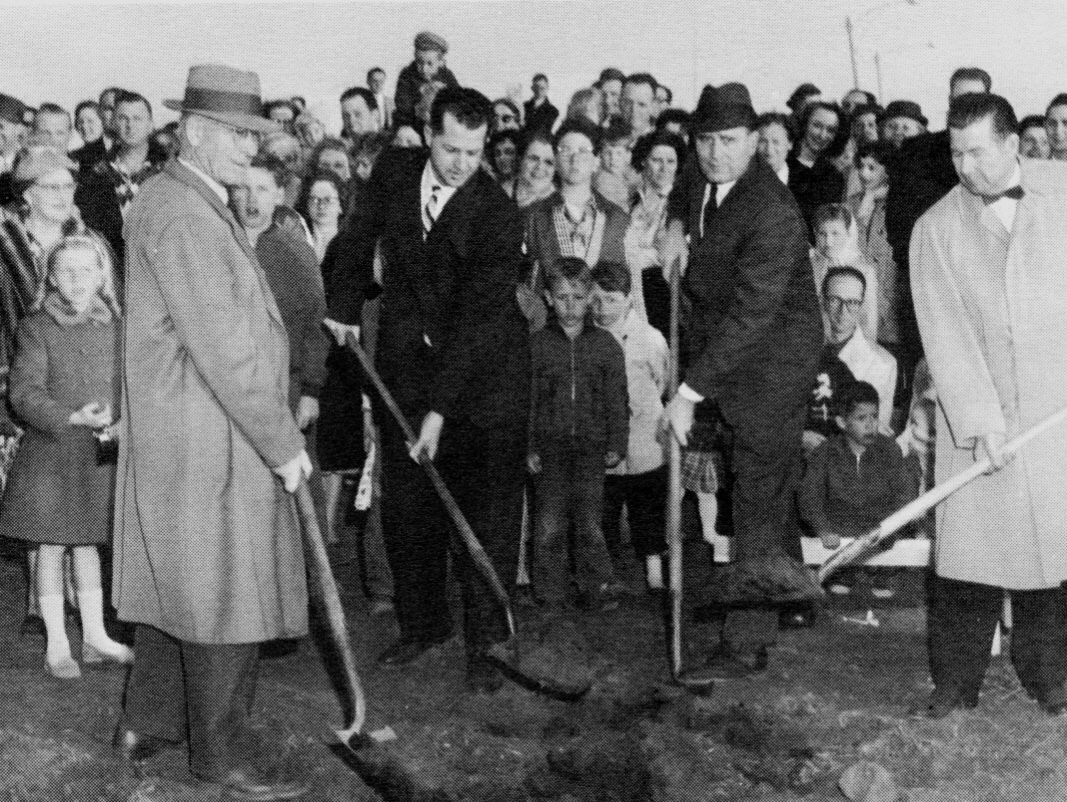 The groundbreaking for the Edmonton Stake Centre was held 19 April 1960, seven months before the creation of the stake. Sod-turners, left to right: Heber Jensen, district president; Kay Burnham, president of Second Branch; James P. Low, building committee chairman; and Parley A. Arave, mission president. (Edmonton Bonnie Doon Stake)
The groundbreaking for the Edmonton Stake Centre was held 19 April 1960, seven months before the creation of the stake. Sod-turners, left to right: Heber Jensen, district president; Kay Burnham, president of Second Branch; James P. Low, building committee chairman; and Parley A. Arave, mission president. (Edmonton Bonnie Doon Stake)
To accommodate the rapidly growing membership, preparations for a new building to house two wards and the stake offices had commenced prior to the creation of the stake. Construction started in 1960, supported by extensive fund-raising and donated labour. Eventually called the Bonnie Doon Stake Centre, the building was dedicated 10 June 1962 by Hugh B. Brown of the First Presidency, who had served impressively in Edmonton in the early 1950s as Gospel Doctrine teacher in both branch Sunday Schools and at the institute.[115] During the dedication service, Brown spoke with great power and inspiration, and some in the congregation felt it was the most spiritually stirring experience they had ever had.[116] Besides giving a moving sermon and offering the dedicatory prayer, Brown also raised his hands as though placing them on the heads of the congregation and pronounced an apostolic blessing upon all those in attendance.[117]
Rollins served tirelessly as the stake president for nearly twelve years, during which time Church members learned to function as a stake, and the stake experienced sustained growth. The Edmonton Stake expanded in January 1963 to include a significant territory south of Edmonton, formerly administered by the Western Canadian Mission.[118] The stake was enlarged to include new branches that were created in Rimbey (1961), Stettler (before 1963), Barrhead (1964), Wetaskiwin (1966), and Lloydminster (1958 but became part of the stake in 1971). By the time Rollins was released in 1972, there were fourteen wards and branches in the stake, including six family wards and a university ward in Edmonton and wards in Cherry Grove and Red Deer.[119]
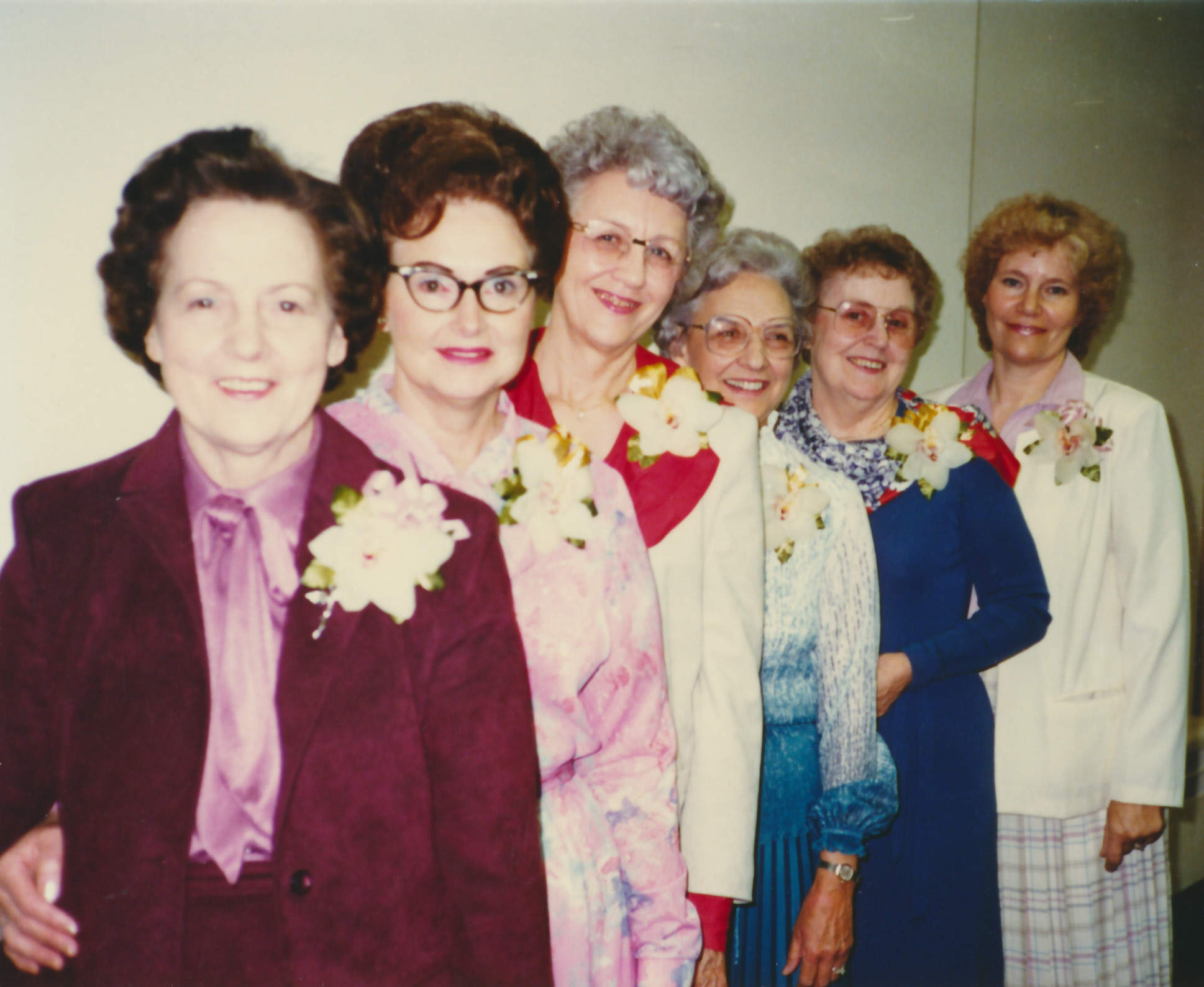 Stake Relief Society presidents from 1960 to about 1972, left to right: Melba McMullin, Marie Burnham, Verona Merkley, Norma Fletcher, Verda Gibb, and Beverley Bateman. (DiAnn Hirsche)
Stake Relief Society presidents from 1960 to about 1972, left to right: Melba McMullin, Marie Burnham, Verona Merkley, Norma Fletcher, Verda Gibb, and Beverley Bateman. (DiAnn Hirsche)
Women provided effective leadership in directing well-run Relief Society, Primary, and Young Women programs. About fifty women from the Edmonton Stake, along with equal numbers from the six other Alberta Stakes, participated in the Alberta women’s choir, which provided music for one session of general conference in October 1967. They were invited in recognition of Canada’s centennial celebration. The group also sang at the Relief Society general meeting, where their performance was recorded.[120]
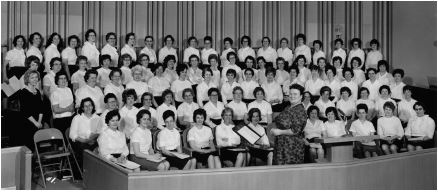 Edmonton Singing Mothers, 1966. About fifty of this group performed in general conference in October 1967. (Wells Photographic Studios)
Edmonton Singing Mothers, 1966. About fifty of this group performed in general conference in October 1967. (Wells Photographic Studios)
In later years, women of Relief Society also provided humanitarian service, including assembling hygiene kits for disaster relief and preparing layettes for new mothers in the local hospitals.[121] In her autobiography, Hattie Jensen said, “I have a strong testimony of what quality women can do as they forget themselves in the service of others.”[122]
Reestablishment of the Edmonton District
In October 1969, in an effort to better serve isolated Church members and branches in northern Alberta, the Western Canadian Mission reestablished the Edmonton District, which had been dissolved in 1960 when the Edmonton Stake was created. Though centred in Edmonton, and although most of the leaders of the district resided in Edmonton, the new district did not include any parts of the Edmonton Stake. Instead, it encompassed a large area outside the boundaries of the stake, including the Cherry Grove, Lloydminster, Rocky Mountain House, Drayton Valley, Hinton, Edson, and Fort McMurray Branches.[125]
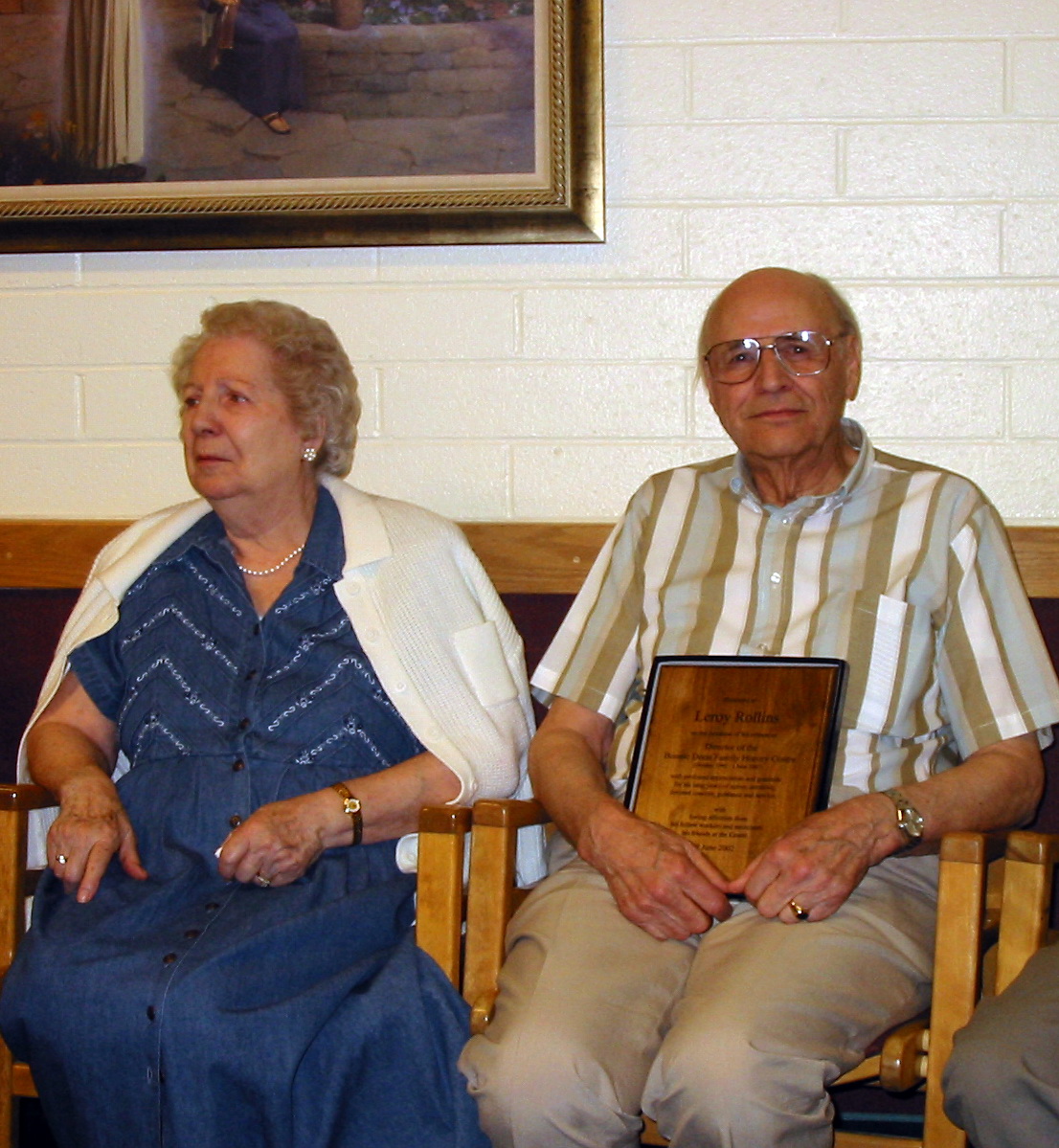 Leroy Rollins, with his wife, Cavell, at his side, served as the first president of the Edmonton Stake and later as patriarch. (Walter C. Meyer)
Leroy Rollins, with his wife, Cavell, at his side, served as the first president of the Edmonton Stake and later as patriarch. (Walter C. Meyer)
Calvin Merkley of Edmonton was appointed district president, with his wife, Verona, as district Relief Society president. Serving with the Merkleys as counselors were Henry and Jeannie Takahashi, also from Edmonton; John C. Webb, from Vermilion, served as a counselor in the district presidency. The district presidency travelled many kilometres almost every Sunday, often on treacherous winter roads, visiting outlying branches to provide support and training. These visits were greatly appreciated by the isolated branches. Church members in Fort McMurray said in 1971, “You are the first church visitors we’ve ever had.”[126] On district conference weekends, the district members gathered in Edmonton, and the leaders’ homes bulged with youth in sleeping bags on the floor.[127] The district continued until 1974, when the units were incorporated into the two Edmonton stakes.[128]
Growth and Division of the Edmonton Stake
On 23 April 1972, Boyd K. Packer of the Quorum of the Twelve presided at stake conference in the Jubilee Auditorium in Edmonton, in which Warren D. Wilde was sustained as the new president of the Edmonton Stake, with counselors Dennis J. Prince and Robert S. Patterson.[129] During the next two years, there was much activity and growth in the stake. New events provided activity for members to interact and learn together, such as the regional MIA dance festival in May 1973 and BYU Education Week in June 1973, which attracted 669 enthusiastic members. In July 1973, a genealogical library conference was held, and in September, there were regional leadership meetings for the Peace River District and the Edmonton, Calgary, and Calgary North Stakes.[130]
With each successive stake conference, attendance increased, until it was necessary to hold conferences in two sessions, beginning in February 1973.[132] Electronic technology was employed. In 1974, stake conference was broadcast (audio) to Cherry Grove and Red Deer for the first time, to reduce travel, and video conferencing was later used for all distanced units.[133] In January 1974, with the revamping of the Church stake-naming system, the Edmonton Stake officially became the Edmonton Alberta Stake.[134] In 1973, the Sherwood Park Ward was created, and the Edmonton Seventh Ward was added in 1974, making a total of seventeen units.[135]
The stake was now well prepared for its division. On 3 November 1974, N. Eldon Tanner of the First Presidency attended the conference of the Edmonton Alberta Stake, held in the Northern Alberta Jubilee Auditorium, with 3,052 in attendance. Under Tanner’s direction, the stake was divided, creating the new Edmonton Alberta East Stake, with Bryant Stringham as president. Warren Wilde was retained as president of the Edmonton Alberta Stake.[136] At the same time, the Edmonton District was dissolved, and its eight branches were incorporated into the two Edmonton stakes.
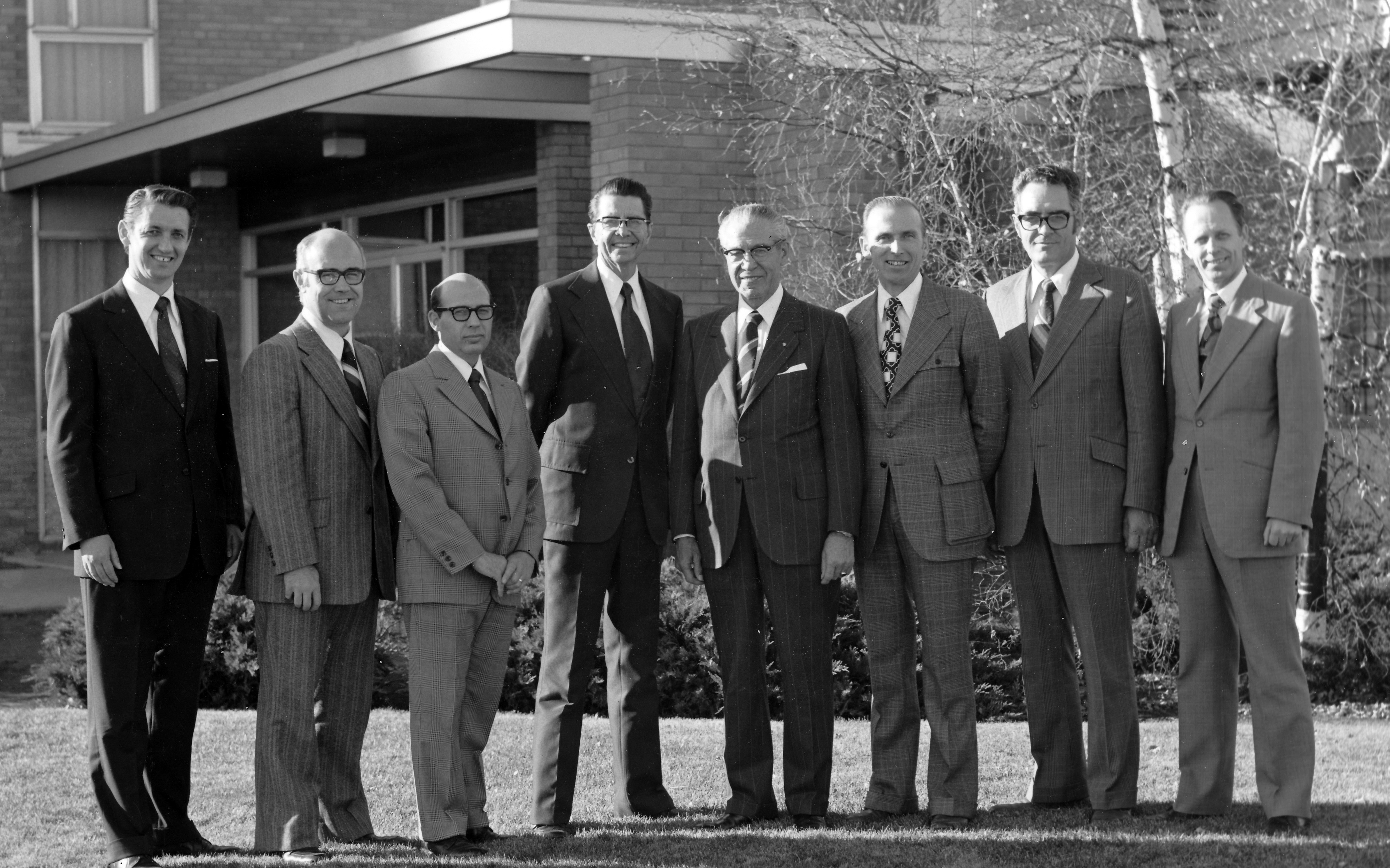 The Edmonton Stake was divided on 3 November 1974, creating the Edmonton East Stake. Left to right: Robert Lundrigan, Robert Patterson, and Warren Wilde of the Edmonton Stake presidency; Rulon Craven; N. Eldon Tanner of the First Presidency; and Bryant Stringham, Dennis Prince, and Thomas Davies of the Edmonton East Stake presidency. (David Henderson, provided by Janis Butler)
The Edmonton Stake was divided on 3 November 1974, creating the Edmonton East Stake. Left to right: Robert Lundrigan, Robert Patterson, and Warren Wilde of the Edmonton Stake presidency; Rulon Craven; N. Eldon Tanner of the First Presidency; and Bryant Stringham, Dennis Prince, and Thomas Davies of the Edmonton East Stake presidency. (David Henderson, provided by Janis Butler)
Calgary Solemn Assembly
Priesthood leaders from Edmonton and northern Alberta attended an Alberta solemn assembly held in Calgary on 2 August 1975, with the entire First Presidency and some other General Authorities in attendance. Spencer W. Kimball, Church president, explained the purpose of the solemn assembly was “to strengthen the priesthood and discuss with them doctrinal and spiritual matters in a direct way.”[138]
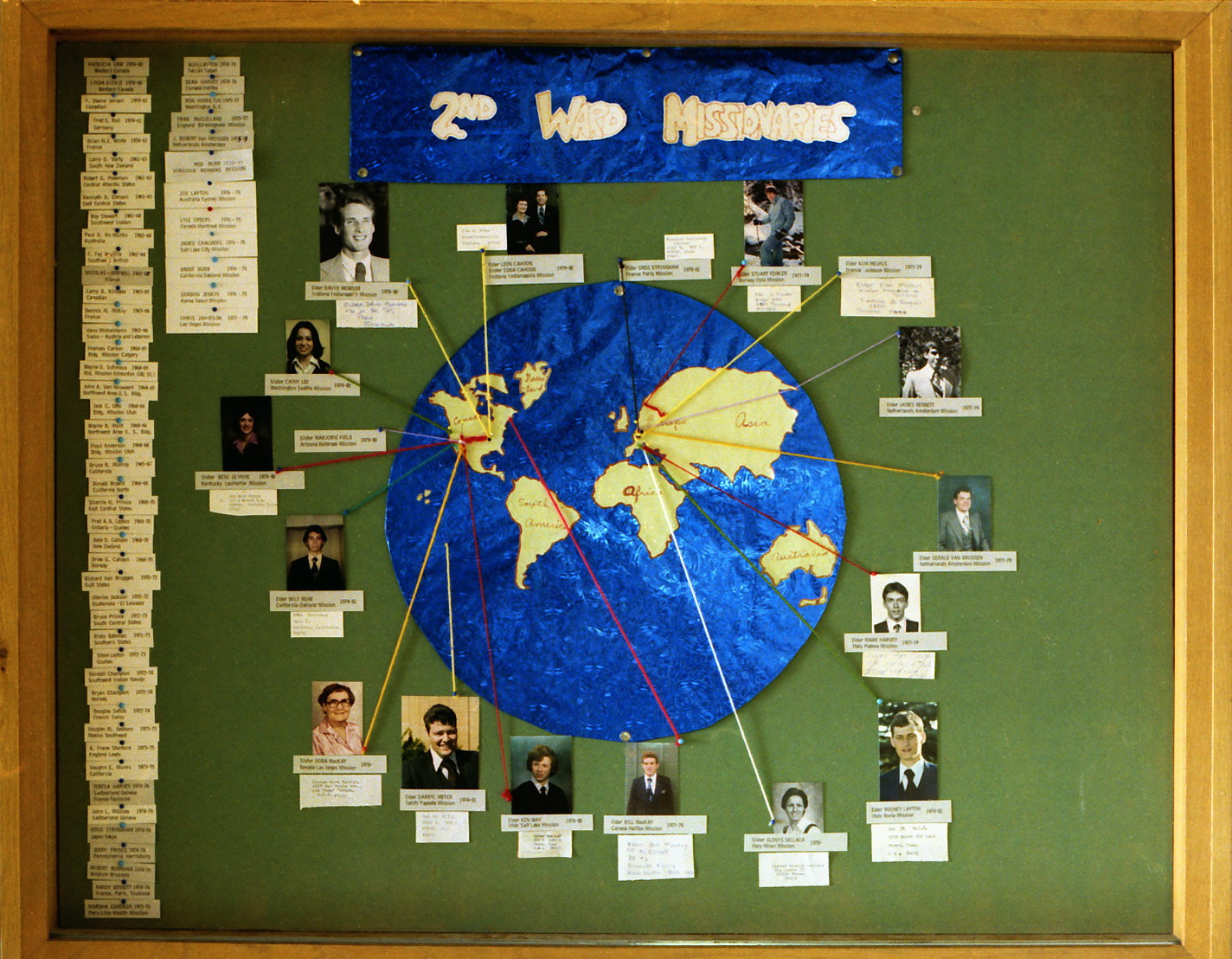 In 1979, the Edmonton Second Ward had an impressive number of its members serving missions—sixteen young missionaries and one senior couple. On the left side of the missionary board are the names of fifty-seven missionaries who had served previously. (Walter C. Meyer)
In 1979, the Edmonton Second Ward had an impressive number of its members serving missions—sixteen young missionaries and one senior couple. On the left side of the missionary board are the names of fifty-seven missionaries who had served previously. (Walter C. Meyer)
The positive effects of the solemn assembly were demonstrated in many ways in the months that followed. One notable example is of the Edmonton Seventh Ward elders quorum president and secretary, who attended the solemn assembly. They were deeply impressed with the instruction to “say nothing but repentance unto this generation” (D&C 6:9) and seriously studied Spencer W. Kimball’s book The Miracle of Forgiveness. They then visited every less-active elder and adult Aaronic Priesthood holder in their quorum, bore their testimonies, and called each to repentance. Instead of “dwelling on the mechanics of repentance and scolding,” they testified to the “joy that comes into one’s life” when the gift of forgiveness is experienced. The result of their efforts was inspiring: 100 percent of the elders in that quorum became fully active, most of the adult Aaronic Priesthood holders received the Melchizedek Priesthood, and many baptisms took place in part-member families.[139]
Growth in Grande Prairie
The Peace Country in northwest Alberta is a significant agricultural area because of the extensive prairie land with good quality soil. Despite the long winters, the area has an extended growing period because of the long days of sunlight in summer. It is possible there to work in the garden at 11:00 pm during the summer.
The first known Latter-day Saint in the Peace Country was Delva Tolman, from Mountain View, Alberta, who arrived by train in September 1932 after a twenty-one-hour journey from Edmonton. She had accepted a position as a teacher in the small Kleskun Hill School. One of the earliest missionaries sent to the area, in about 1943, was Philip T. Sonntag, who later served in the First Quorum of the Seventy. The George O’Brien family came in 1945, and Walter Scott came with his wife, Irene, in 1947.[140]
The Peace River missionary district was opened in October 1947 with five pairs of elders, and in April 1948, the Grande Prairie Branch was created. An early convert was Chester Horton, who, in July 1948 in the Fairview-Dunvegan area, had given a ride to two young men from Utah. Horton and his family were baptized in June 1949, and he became the fourth branch president in 1953. Philip Proctor, an engineer transferred by his company from Lethbridge in 1958, became branch president in 1959.[141]
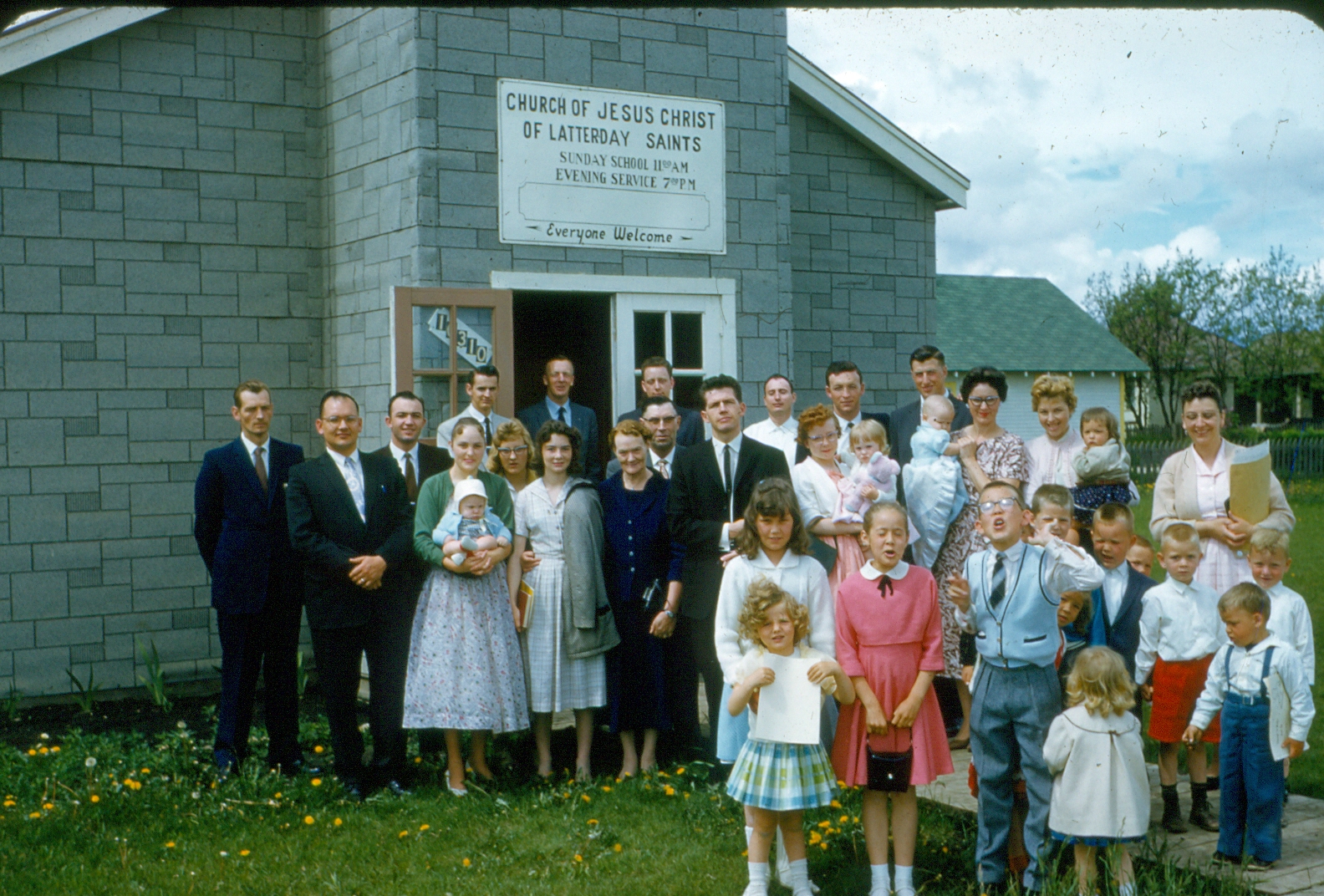 Church members in Grande Prairie held services in this meetinghouse in the early years of the branch. (Philip F. Proctor)
Church members in Grande Prairie held services in this meetinghouse in the early years of the branch. (Philip F. Proctor)
There are many stories of healings and of the manifestation of priesthood power among the Saints in Edmonton and northern Alberta. One example is that of Michael Radke, a farmer who regularly attended church even though he lived more than 90 miles (145 kilometres) from Grande Prairie. Radke was losing his hearing, and medical professionals had been unable to help. While attending a Grande Prairie branch conference on 5 February 1961, Radke requested and received a blessing from the mission president, Parley A. Arave. At the completion of the ordinance, Radke stood up and exclaimed, “I can hear! I can hear!” He related that as the president started the blessing, he heard only muffled sounds, but before it was finished, “something snapped,” and he heard the remainder of the blessing perfectly.[142]
On 24 March 1963, the Peace River District was created, with Philip Proctor as district president. The Grande Prairie (1948) and North Star (before 1962) Branches were included in the district, as well as the Dawson Creek (1956) and Fort St. John (1961) Branches in northern British Columbia.[143] The Peace River District, which was later renamed the Grande Prairie District, had 350 members at its creation. Later, a dependent branch was formed in Peace River (1964) and a branch in Hudson’s Hope, British Columbia (1968), further expanding the size of the district.[144]
These branches were located at considerable distances from one another. The farthest branch, Hudson’s Hope, was 298 kilometres from Grande Prairie, but others were also two to three hours’ drive. In his setting-apart blessing, Proctor was promised that as he served, he would have no serious travel problems or accidents. During the next seven years, he travelled many thousands of kilometres on district business in his own car each year, often on gravel roads, and testified that the blessing had been fulfilled: he didn’t have as much as a flat tire.[145]
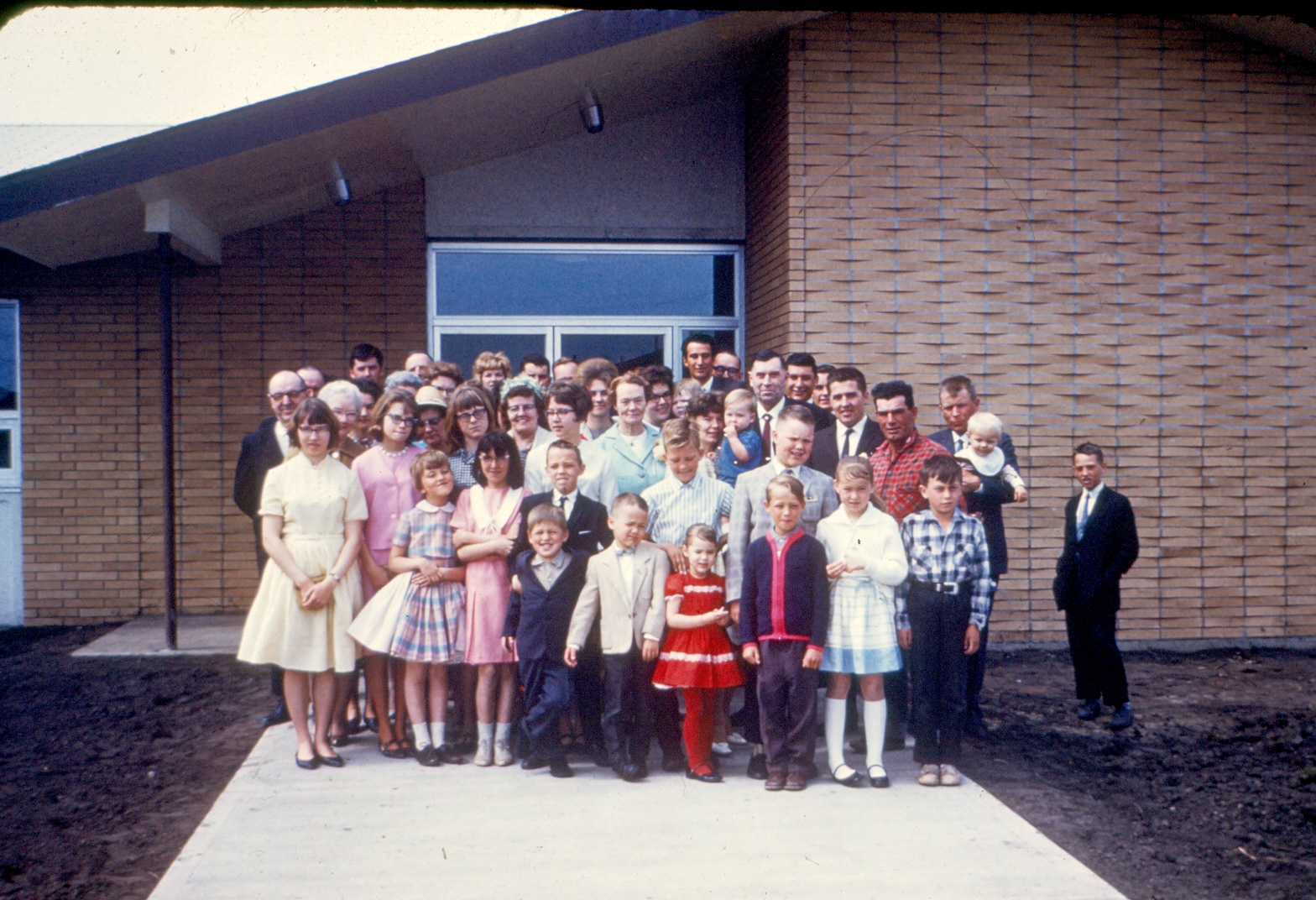 The Grande Prairie meetinghouse was dedicated in May 1965, when this photograph was taken. (Philip F. Proctor)
The Grande Prairie meetinghouse was dedicated in May 1965, when this photograph was taken. (Philip F. Proctor)
Population increased in Grande Prairie, an important regional centre of trade and agriculture. In 1966, the district received a boost when the Grande Prairie Regional College was established. The college drew people to the community, such as LaRon Woolley and Kelvin Johnson, who accepted teaching positions, helping the Church grow not only numerically but also in maturity. Woolley accepted many leadership positions over the years, including branch president, district president, and stake patriarch, and also served elsewhere as mission president and temple president.[146]
Philip Proctor was pleased to report at the end of his term as district president that the district sent out eighteen young men on missions in the previous decade.[147] By the time of Proctor’s release in 1970, the district membership had doubled to seven hundred.[148]
In the years that followed, more branches were added to the district, including Valleyview (1976), High Prairie (1979), High Level (1979), Beaverlodge (1979), Fairview (1982), and Tumbler Ridge (1985).[149] At district conference on 13 September 1987, there were 628 in attendance.[150] The Grande Prairie Alberta Stake was created on 12 April 1998, with Lennard R. Shaw as the first stake president and counselors Richard Gilson and Ronald Peterson.[151]
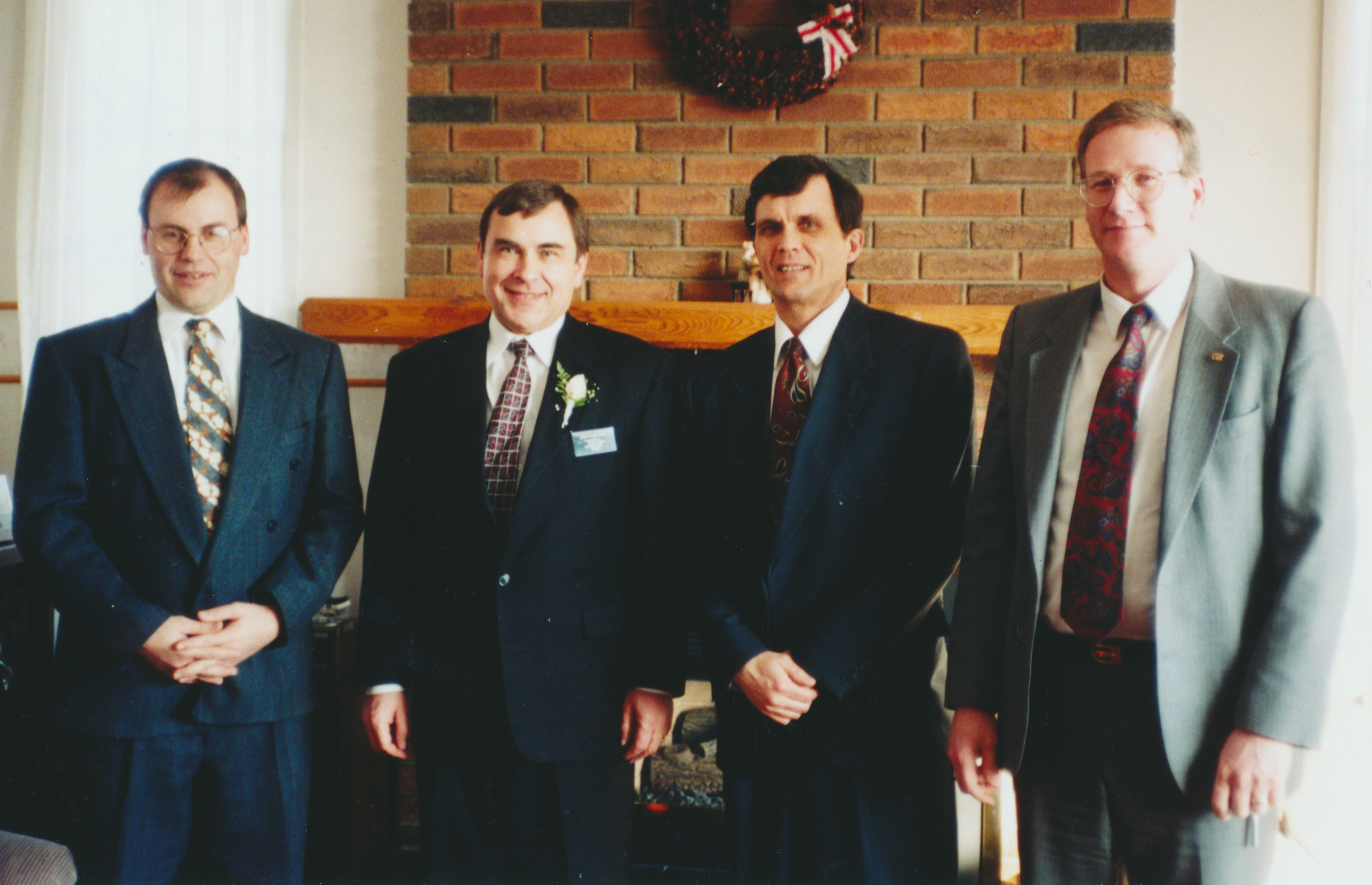 Grande Prairie’s first stake presidency. Left to right: Richard Gilson, first counselor; Peter Berkhahn, mission president; Lennard R. Shaw, stake president; Ronald Peterson, second counselor. (Ronald Peterson)
Grande Prairie’s first stake presidency. Left to right: Richard Gilson, first counselor; Peter Berkhahn, mission president; Lennard R. Shaw, stake president; Ronald Peterson, second counselor. (Ronald Peterson)
Formation of the Red Deer Stake
When the Edmonton Stake was divided in 1974, N. Eldon Tanner of the First Presidency recommended that a district be formed in Red Deer in the near future. In October 1975, Ezra Taft Benson of the Quorum of the Twelve created the Red Deer District, containing the Red Deer, Coronation, Wetaskiwin, Rimbey, Rocky Mountain House, and Stettler Branches.[152] Stanley Swainson became the first district president. The new district had a membership of 505. In 1982, after several years of steady growth, the district became the Red Deer Alberta Stake, with Dennis Guenther as stake president and a total membership of 2,308.[153]
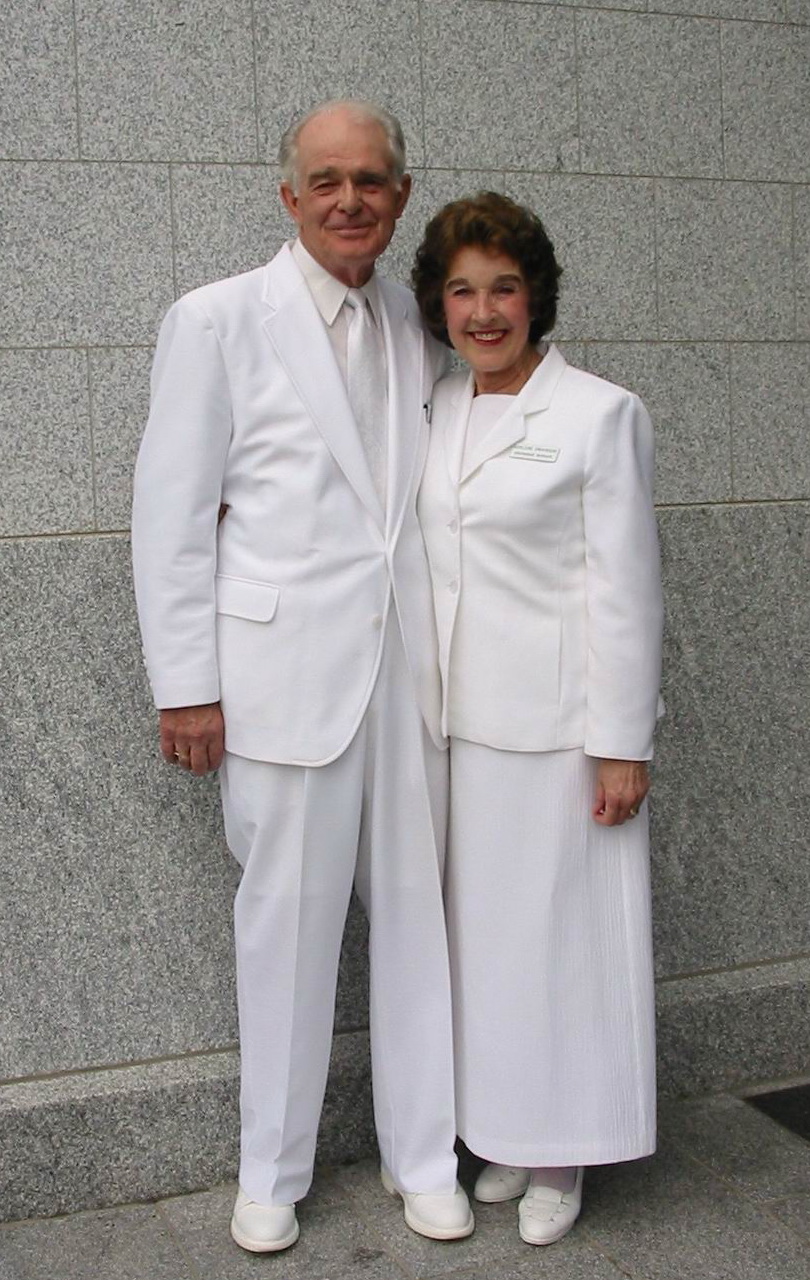 Stanley and Dorlene Swainson, 1999. In 1945, Dorlene (Blades) and her twin sister, Donabelle, were the first converts in Red Deer. Dorlene introduced the gospel to Stanley Swainson, who was baptized in 1948. Stanley became the first bishop of the Red Deer Ward in 1961 and was the first president of the Red Deer District in 1975. The Swainsons became workers in the Edmonton Temple in 1999, with Stanley as one of the first six sealers. (Walter C. Meyer)
Stanley and Dorlene Swainson, 1999. In 1945, Dorlene (Blades) and her twin sister, Donabelle, were the first converts in Red Deer. Dorlene introduced the gospel to Stanley Swainson, who was baptized in 1948. Stanley became the first bishop of the Red Deer Ward in 1961 and was the first president of the Red Deer District in 1975. The Swainsons became workers in the Edmonton Temple in 1999, with Stanley as one of the first six sealers. (Walter C. Meyer)
Expanded Programs and Community Service
As the Church became stronger in the Edmonton area, its programs were expanded. In the early 1970s, the Church established a family history centre and began administering welfare projects. Likewise, building on long-term development, the Church contribution in the community to music and culture, academe and politics became more visible. A significant number of civic and Church leaders had Edmonton roots.
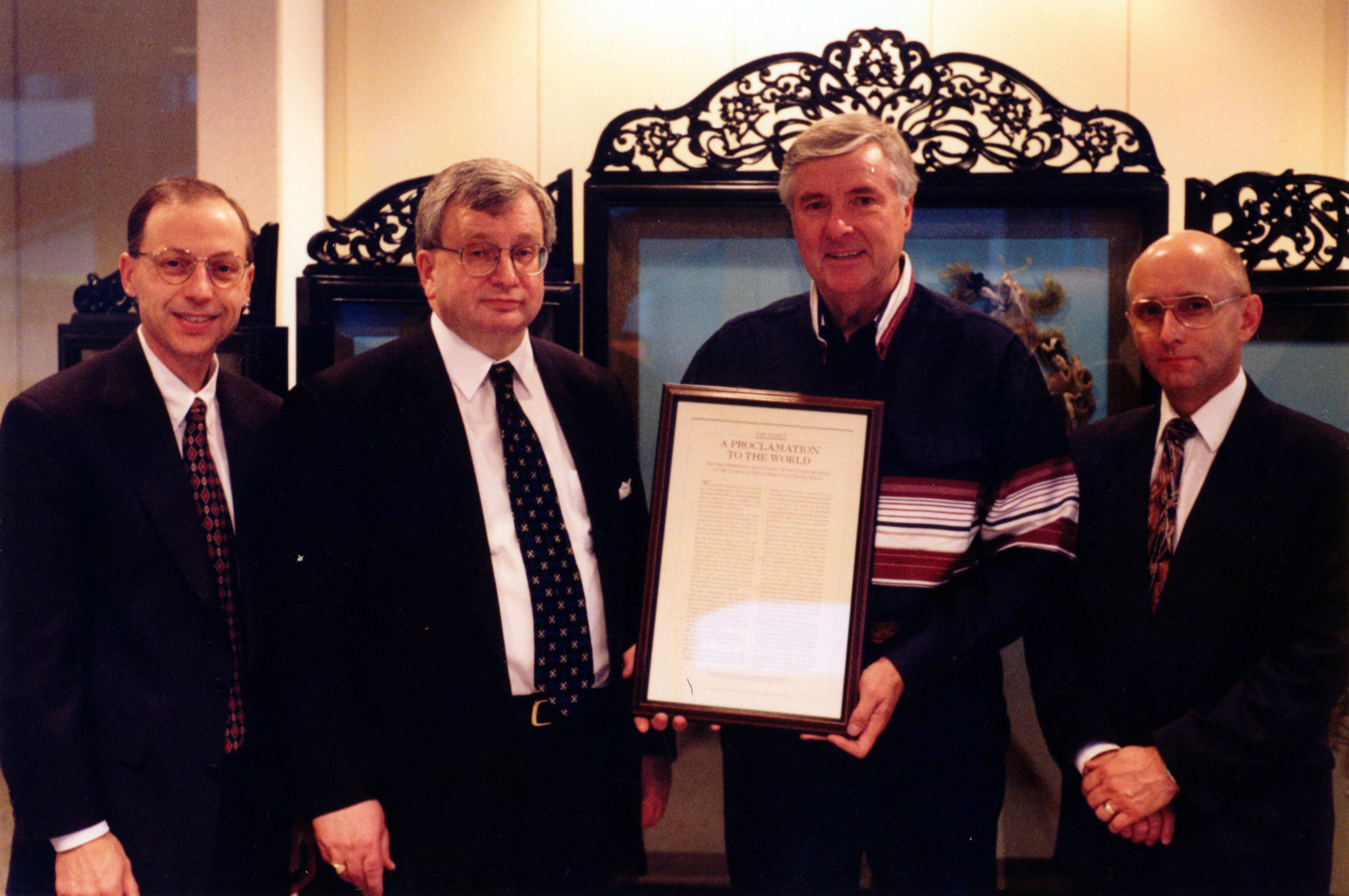 On 8 November 1996, three Edmonton stake presidents visited city hall and presented a copy of the family proclamation to Mayor Bill Smith. Left to right: Don Sommerfeldt (Millwoods), Robert White (Riverbend), Mayor Bill Smith, and David Henderson (Bonnie Doon). (Edmonton Bonnie Doon Stake)
On 8 November 1996, three Edmonton stake presidents visited city hall and presented a copy of the family proclamation to Mayor Bill Smith. Left to right: Don Sommerfeldt (Millwoods), Robert White (Riverbend), Mayor Bill Smith, and David Henderson (Bonnie Doon). (Edmonton Bonnie Doon Stake)
Family History Centres
A family history centre was established in the Bonnie Doon stake centre in 1973, with Rune Backstrom as the centre director.[154] The centre, located in the junior Sunday School room, had a unique design in which the microfilm readers could be lowered for use in searching films and in the extraction program but could be raised to the ceiling when not in use.[155]
The centre was the only family history centre in Edmonton for many years, until one was established in the Riverbend Stake in 1987. Staffing was provided by members of all Edmonton stakes. Members cooperated with the Alberta Genealogical Society to accomplish much family history work over the years.[156]
Church Welfare Projects
While the Edmonton chocolate project originated as a building-fund project, after the dedication of the stake centre in 1962, the project was also used significantly to raise welfare funds until it was discontinued in 1976.
A stake welfare farm located several miles west of Edmonton and near Wabamun Lake was purchased in 1976 during the presidency of Bryant Stringham of the Edmonton Alberta East Stake (later becoming the Edmonton Alberta Bonnie Doon Stake). That stake held the farm stewardship for several years, but the farm was also supported by the leaders and members of the Edmonton Alberta Stake.[158]
The farm covered 1,500 acres and originally had 300 acres under cultivation. As a result of volunteer work projects over a period of approximately seven years, supervised by Ron Holland and Ken Ross on stake assignment, the cultivated area was increased to 700 acres. Because Holland and Ross had connections to both the business and oil industries, they were able to arrange beneficial leases related to mineral rights that made the farm very cost effective. In fact, it was one of a small number in the Church that was profitable.[159] The farm machinery, purchased as economically as possible, had been maintained in such good repair by Paul White—a local member, volunteer, and friend of Holland who worked professionally as a mechanic—that when the farm was eventually sold more than a decade later, in the late 1980s, the machinery brought in more money than what it had originally cost.[160]
Another welfare project, a raspberry patch near Beaumont (about six kilometres south of Edmonton) began as a project of the Edmonton First Ward in 1969 and continued until the land was sold six years later. The fruit was never sold commercially, but members could use it for their own families.[161]
In 1978, a site for a bishop’s storehouse and cannery was purchased in Sherwood Park. Although the building was constructed in the Edmonton Alberta East Stake, it functioned for both stakes.[162]
Edmonton Music and Culture
Festivals and cultural celebrations were held frequently from the early years of the Church in Edmonton, including music, dance, and quartet festivals in addition to road shows and sports tournaments. Stage productions, including musicals, were often presented. In 1948, a Gilbert and Sullivan operetta was sponsored as a fund-raiser;[163] Promised Valley, composed by Crawford Gates for the 1947 pioneer centennial, was a highlight of stake activity in the early 1960s.[164]
This tradition has continued to the present, with dozens of musicals over the years, including Fiddler on the Roof, Joseph and the Amazing Technicolor Dreamcoat, and Scrooge, the Musical. Numerous concerts and stage productions in the community have featured Latter-day Saint performers—pianists, vocalists, instrumental musicians, and actors. Latter-day Saint Christmas concerts, Messiah performances, and music festivals in Edmonton have been outstanding. The talents of the Edmonton Saints and their willingness to share them have been a significant contribution to the cultural life of Edmonton.[165]
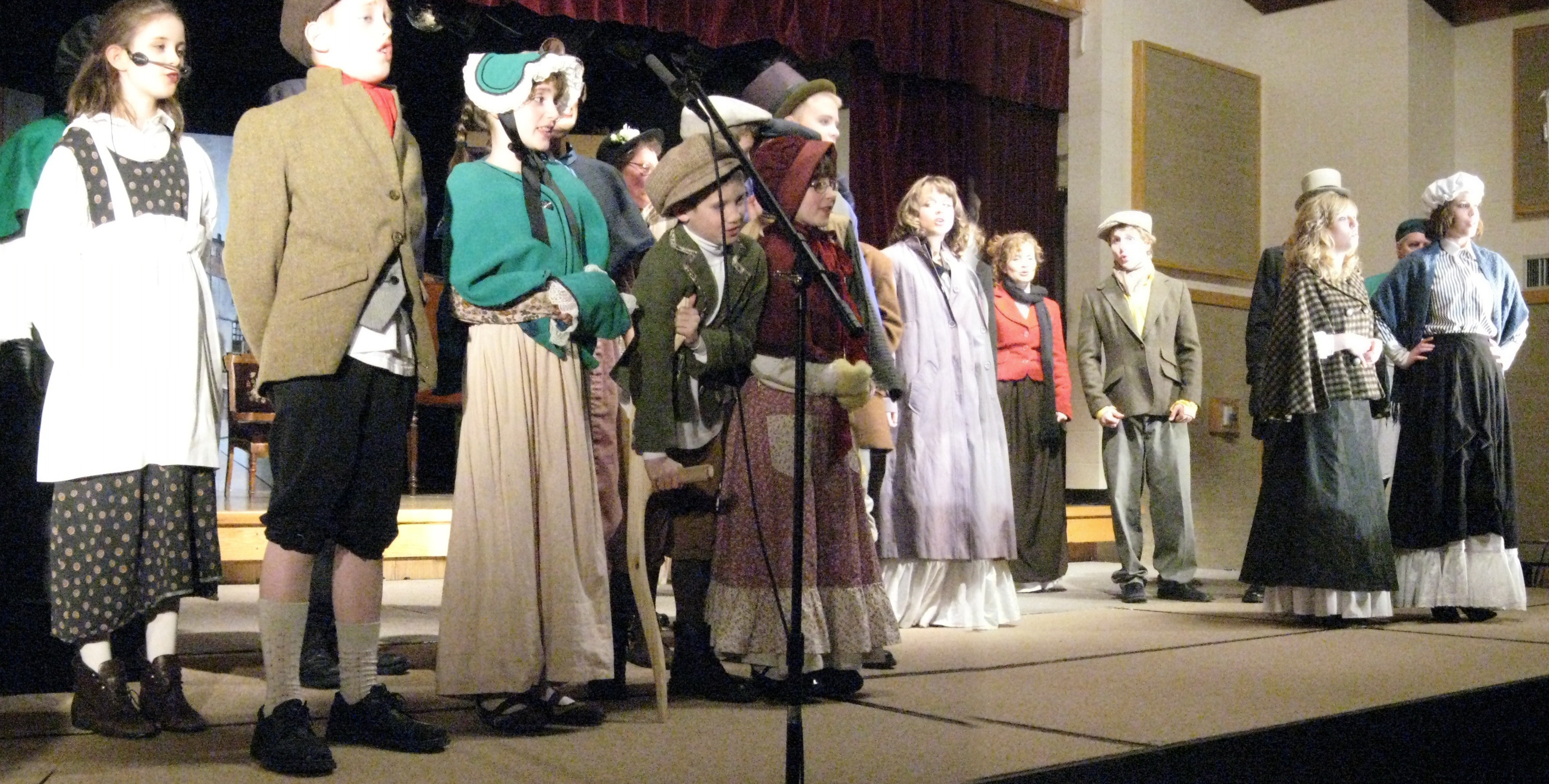 This Clarkdale Ward production of Scrooge, The Musical, directed by Janis Butler, was performed for the community in the Sherwood Park meetinghouse in 2009. (Patrick Reid)
This Clarkdale Ward production of Scrooge, The Musical, directed by Janis Butler, was performed for the community in the Sherwood Park meetinghouse in 2009. (Patrick Reid)
Edmonton has also hosted Latter-day Saint musicians from Salt Lake City, including Alexander Schreiner, who gave an organ concert at the Edmonton stake centre soon after its completion, and the Mormon Tabernacle Choir, which performed twice in 1975. These events were attended and appreciated by many members of the Edmonton community.[166]
Academic Staff
The University of Alberta, which opened in 1908, has included more than a dozen Latter-day Saints in the academic staff over the decades, starting with Brigham Y. Card, a sociologist, in the 1940s. Others include George Jarvis, sociology; Robert Patterson and Warren Wilde, education; George H. Gibb, Walter Meyer, Kent Gibb, and Steve Patterson, dentistry; Malcolm Asplund and Darrel Murri, agriculture; Michael Murdock, drama; Tom Davies, chemistry; and Derril Butler, English.[167] There have also been LDS instructors at the Northern Alberta Institute of Technology in Edmonton.[168] While Latter-day Saints have served in many professions, they seem to have had a particular proclivity for teaching. Melvin Sillito served for many years as coordinator of professional development of the Alberta Teachers Association, and at one time in 1967 there were fifty-four teachers in the Edmonton First Ward alone.[169]
Politics
Many Latter-day Saints have been employees of the Alberta provincial government, but a few have held high-profile political positions, such as N. E. Tanner and Solon Low. Edgar Hinman served as provincial treasurer from 1955 to 1964. Many other Church members were elected as MLAs from southern Alberta over the years, but because they were in Edmonton only during the sitting of the Legislative Assembly, they have not been viewed as Edmontonians. David Dorward, educated in and a longtime resident of Edmonton, was elected in 2012 as the first Latter-day Saint to become an Edmonton MLA. Nonelected government officials have included Heber Jensen, Vi A. Wood, Glen R. Purnell, who served as deputy ministers; Cathryn Landreth, an assistant deputy minister; and other senior administrators, such as Robert Gehmlich, Mel Wong, Kevin Molcak, and Alan Champion.[170]
In the City of Edmonton, Sig Dietze was the chief commissioner of the city for many years in a nonelected position. Cecil J. H. Purves served as a city alderman from 1966 until 1974 and then as mayor of Edmonton from 1977 until 1983. He was the first native-born Edmontonian to be elected as mayor, but “Cec,” a convert to the Church, was also the first native-born Edmontonian to be an LDS bishop in Edmonton.[171]
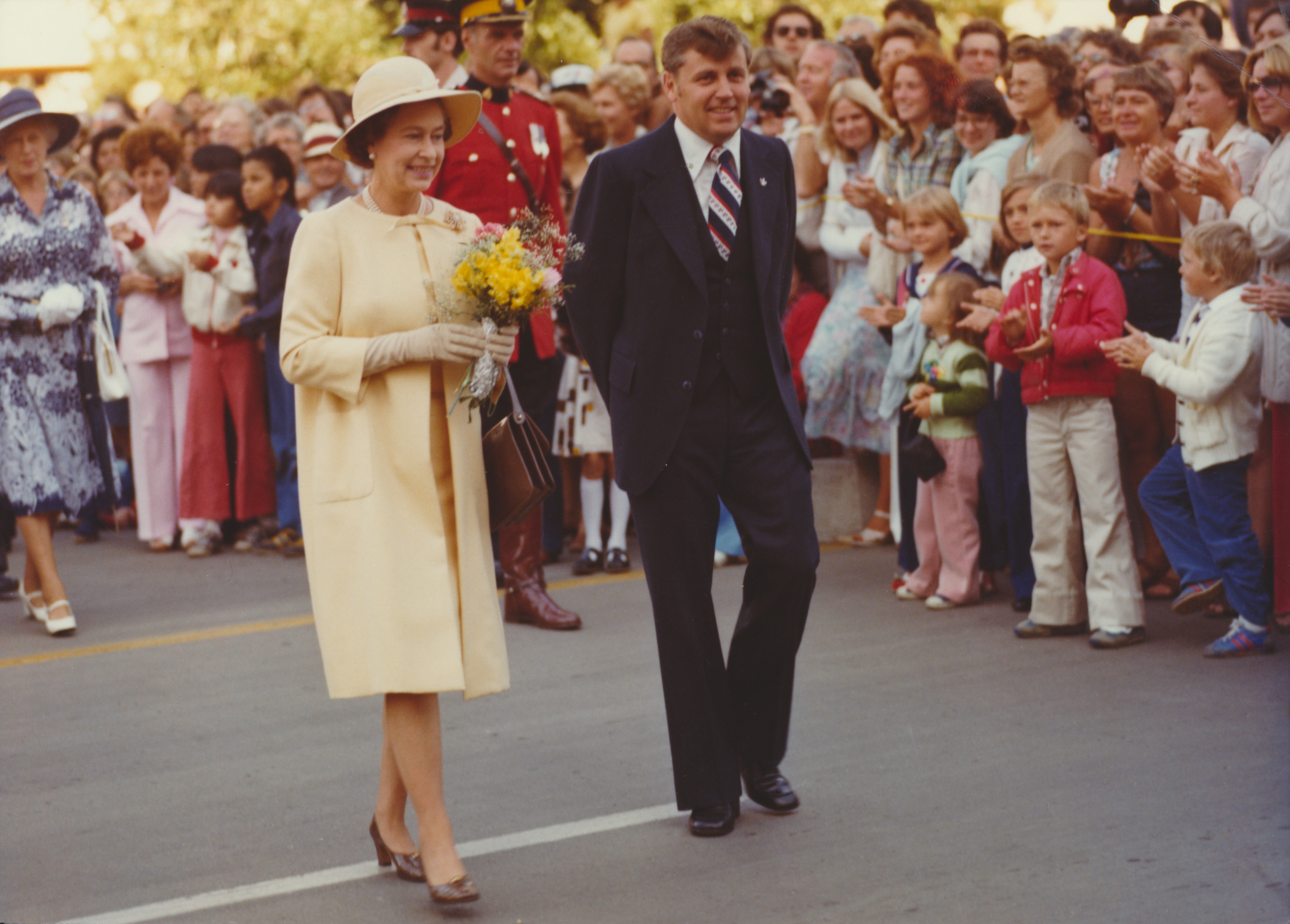 In 1978, Edmonton hosted the Commonwealth Games, and Queen Elizabeth attended. Cecil Purves, mayor of Edmonton, escorted her at various official functions. (Cecil Purves)
In 1978, Edmonton hosted the Commonwealth Games, and Queen Elizabeth attended. Cecil Purves, mayor of Edmonton, escorted her at various official functions. (Cecil Purves)
In addition to the ways mentioned above, LDS involvement in the community has included Scouting and many other activities. Such participation has raised the profile of the Church and provided for a better integration of the members within the community. As in other places in Alberta, where the Church has a significant presence, people generally have come to appreciate the Mormon contribution.
Formation of Two New Stakes in Edmonton
In the 1980s, Church membership continued to grow unabated in Edmonton, resulting in the formation of two new stakes. On 6 November 1983, a large two-stake conference was held in the Universiade Pavilion (affectionately called the Butterdome), at which the Edmonton Alberta Stake became the Edmonton Alberta Riverbend Stake; the Edmonton Alberta East Stake became the Edmonton Alberta Bonnie Doon Stake; and a third Edmonton stake, the Edmonton Alberta Millwoods Stake, was created, with Kenneth O. Higginbotham, president, and counselors Robert Zemp and Darrel Hudson.[172] In 2001, a fourth stake, the Edmonton Alberta North Stake, was created, with Brent A. Purnell, president, and counselors Robert van Bruggen and John Nelson.[173]
On 5 June 2011, the Yellowknife Branch (organized in 1983) was transferred from the Canada Edmonton Mission and was made a part of the Edmonton Alberta North Stake. Because of the great distance between Edmonton and Yellowknife (1,490 kilometres), Yellowknife Branch members sometimes use personal video conferencing, Skype, and other electronic means to attend meetings and participate in the events of the stake.[174]
Stake Publications and Heritage Events
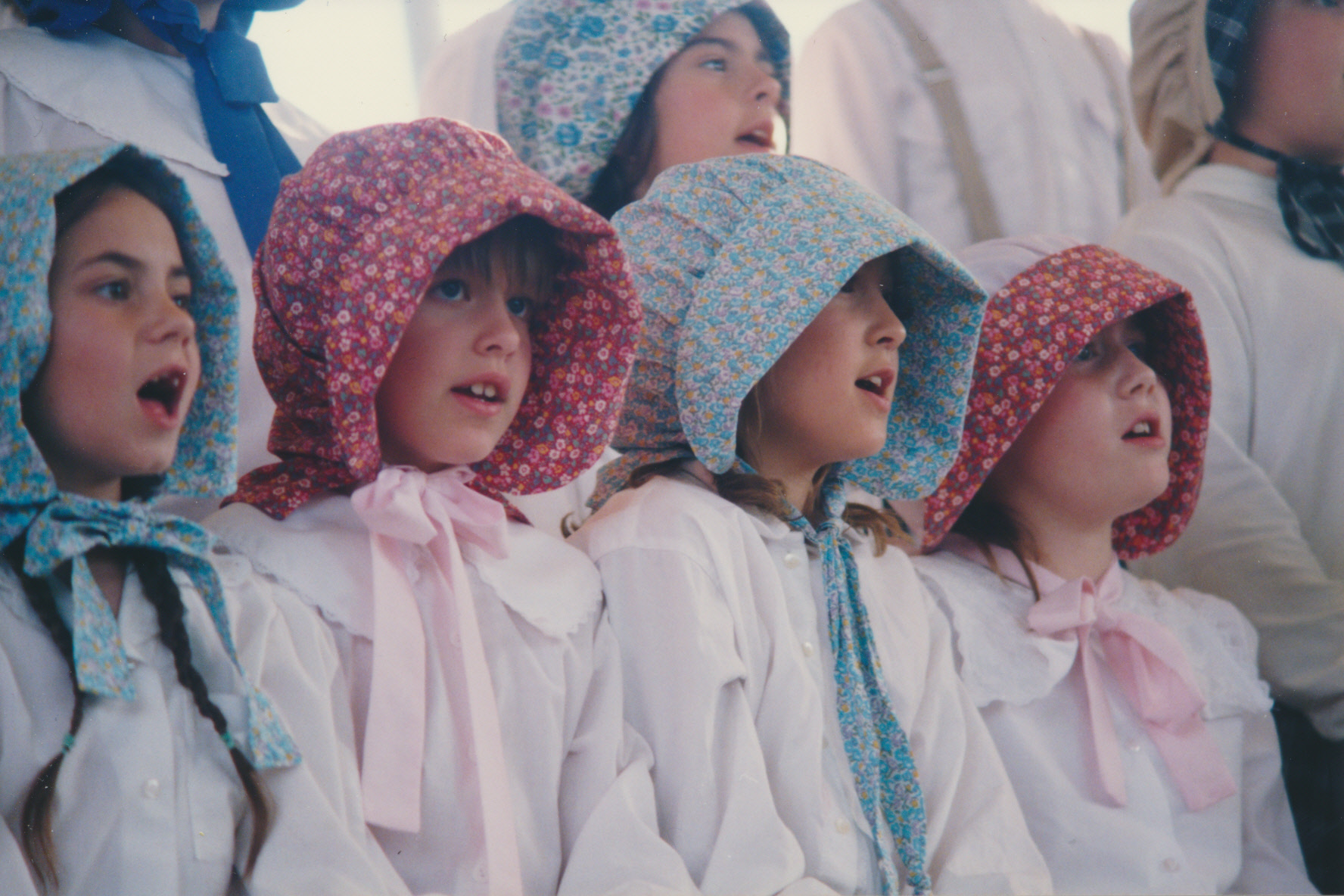 Children of the Riverbend Alberta Stake remember their pioneer heritage in a 1997 pioneer celebration. (Edmonton Riverbend Stake)
Children of the Riverbend Alberta Stake remember their pioneer heritage in a 1997 pioneer celebration. (Edmonton Riverbend Stake)
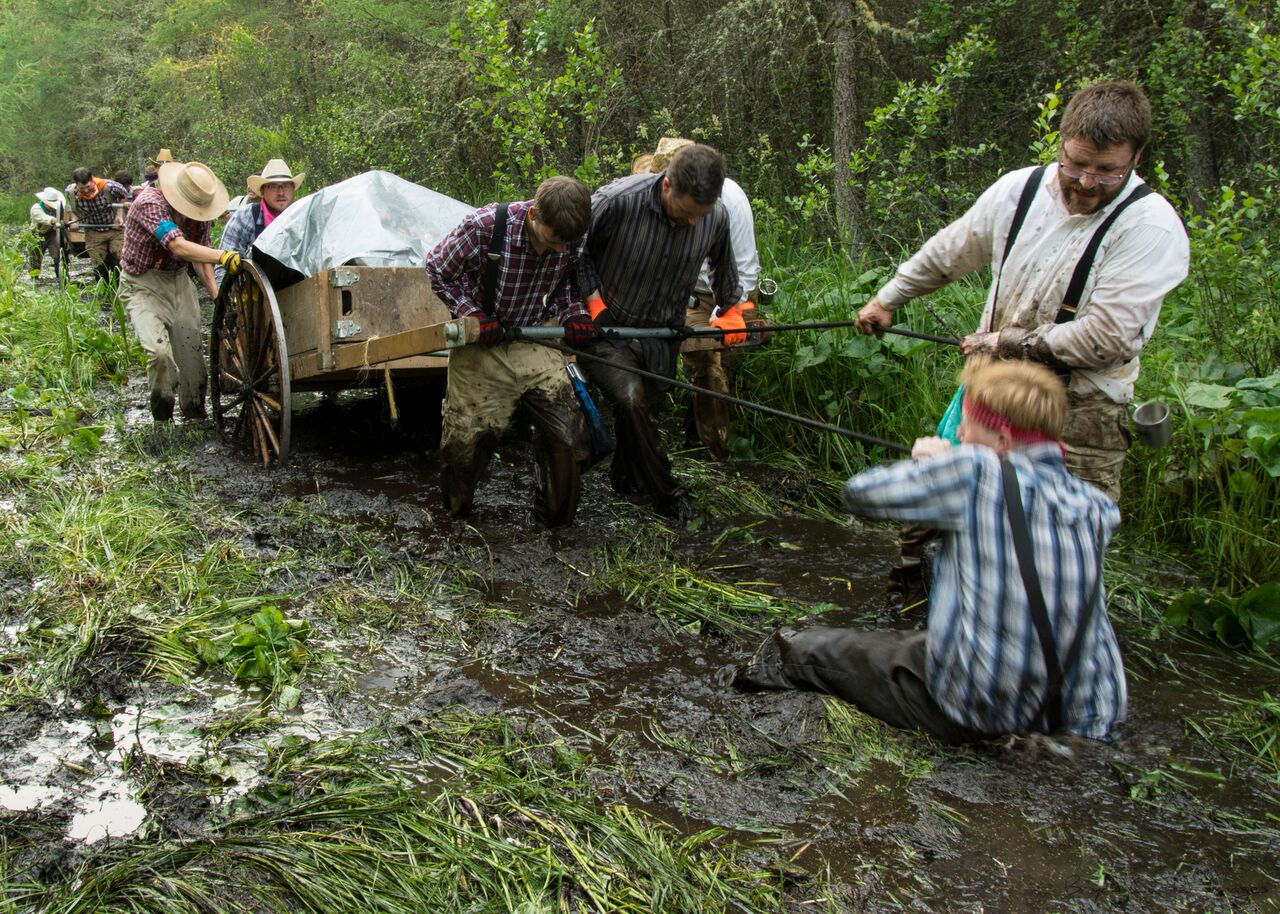 Stuck in the mud at a 2014 trek for youth and adults of the Edmonton Alberta Bonnie Doon Stake. Those participating in pioneer trek reenactments come to feel firsthand the trail experience. (Edmonton Bonnie Doon Stake)
Stuck in the mud at a 2014 trek for youth and adults of the Edmonton Alberta Bonnie Doon Stake. Those participating in pioneer trek reenactments come to feel firsthand the trail experience. (Edmonton Bonnie Doon Stake)
Two stakes undertook the publication of historical and testimonial publications near the turn of the century. The first, Tribute to the Pioneers of the Church in Edmonton, was produced by the Millwoods Stake in 1997 for the 150th anniversary of the Mormon pioneers’ arrival in the Salt Lake Valley. This volume contains reminiscences by a number of former Edmonton Church leaders and long-standing members.[175] In December 1999, a millennial book project entitled Northern Light was published by the Bonnie Doon Stake. Four hundred fifty stake members responded to the invitation to share brief accounts of their conversion or a faith-promoting experience in a three-hundred-page book.[176] These two volumes gave tangible witness of “the tender mercies of the Lord” to those faithful Saints who laid the foundation of the Church in northern Alberta.
The heritage of Latter-day Saint pioneers has also been the focus of major events involving children and youth. The spiritual development of children and young people has long been a priority of Church leaders in Edmonton and other areas of northern Alberta.[177]
The Edmonton Alberta Temple
In writing about spiritual highlights in Northern Light, one Edmonton stake president pointed out that there are always three goals: to strengthen the Saints, to have the Church grow, and to have more members participate in temple worship.[178] Surely the most important event pertaining to the spiritual welfare of souls in the Edmonton and northern Alberta region was the dedication of the Edmonton Temple.
The Edmonton Alberta Temple was announced on 11 August 1998 by Church President Gordon B. Hinckley, nine days after he spoke to a gathering of about nine thousand, the largest number of members to ever gather in Edmonton.[179] News of the new temple electrified the Saints in Edmonton as they anticipated the great blessing that would soon be theirs. Saints who had routinely driven seven or more hours each way to attend the temple in Cardston eagerly attended the groundbreaking on 27 February 1999. Many followed the construction with excitement, and a large group gathered to witness the raising of the statue of the angel Moroni atop the structure on 1 September. In anticipation for the opening of the temple, much genealogical research was done as Church members prepared to do temple ordinances for their ancestors. The open house was held between 1 and 7 December. Gordon B. Hinckley dedicated the temple on 11 December 1999, with six other dedicatory sessions being held later that day and on 12 December.[180]
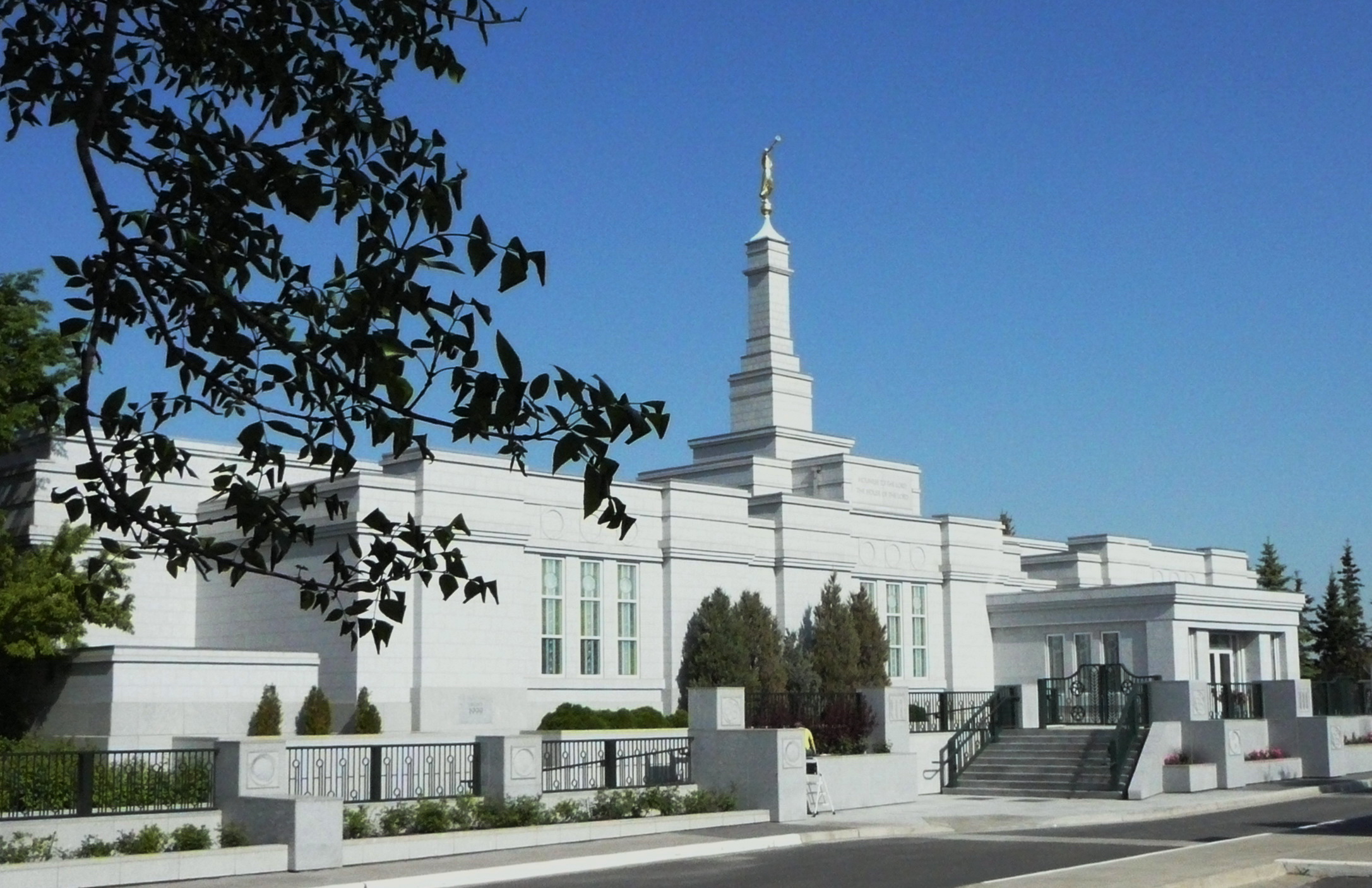 The Edmonton Alberta Temple, dedicated in 1999, is a symbol of permanence to the LDS community in northern Alberta. (Walter C. Meyer)
The Edmonton Alberta Temple, dedicated in 1999, is a symbol of permanence to the LDS community in northern Alberta. (Walter C. Meyer)
Donald D. Salmon and his wife, Joyce, were appointed the first president and matron of the Edmonton Alberta Temple. Subsequent temple presidents and matrons include Robert and Belva Patterson, Jack and Rita Holt, Bryce and Katherine Card, and most recently Darrel and Janae Harker, who commenced their responsibilities in November 2014.[181] Since the dedication of the Edmonton Alberta Temple, many members have received and performed sacred ordinances for both the living and the dead. The temple evidenced the maturity and strength of the Church in the northern part of the province and serves as a spiritual anchor for the Saints.
The Church in the New Century
The Canada Edmonton Mission
The Canada Edmonton Mission, announced by President Hinckley in January 1998, was officially established on 1 July 1998, with Richard M. Andrus presiding over 137 missionaries.[182] By the end of the year, the number increased to 151. After 2012, when the age of missionary eligibility was lowered to eighteen for men and nineteen for women, missionary numbers increased dramatically. By the spring of 2014, there were 240 missionaries in the mission. Prior to 2012, the average number of sister missionaries in the mission was 12, but by 2014 there were 50, with even more expected.[183]
Caring for those in need continues to be a part of life for Church members in northern Alberta. On 15 May 2011, a forest fire swept through the town of Slave Lake, 250 kilometres north of Edmonton, forcing the evacuation of the town’s seven thousand residents. Many homes, some government buildings and schools, and the meetinghouse of the Slave Lake Branch were destroyed. Some of the evacuated Church members were housed in the meetinghouse of the Athabasca Branch, over 100 kilometres to the southeast. Relief Society and priesthood leaders of the Edmonton Alberta Riverbend Stake provided food and other supplies to the displaced Church members and donated hygiene kits to the community.[185]
In early May 2016, a massive wildfire, the costliest natural disaster in Canadian history, engulfed Fort McMurray.[186] Nearly 90,000 residents, including 498 members of the Church, fled with just a few belongings.[187] The fire burned out of control until early July 2016, destroying 2,400 homes and buildings and burning nearly 600,000 hectares (1.5 million acres) of forest. Miraculously, no lives were lost in the fire.[188]
Tod Beaulne, called just days before as the bishop of the Wood Buffalo Ward in Fort McMurray, and the leaders of the Edmonton North Stake, using cell phones and social media, kept track of Church members, shepherding them to safe refuge in Edmonton, Red Deer, Calgary, and southern Alberta.[189] Thirteen LDS families, including the elders quorum president and the author’s granddaughter, lost their residences to the fire. The LDS meetinghouse survived the fire but suffered significant smoke damage.[190] Emergency supplies were sent from the bishop’s storehouse in Lethbridge to assist evacuees.[191] The response to this disaster was a fine example of people in the Church and the community working together to assist one another in a time of crisis.
Five Decades of Stakehood
In 1949, two years before the Whyte Avenue meetinghouse was dedicated, there were 488 members in the Edmonton Branch, a significant increase from the 17 people who attended the first recorded meeting in 1933. By 1960, when the Edmonton Stake was formed, there were 2,126 members in the stake, and by December 2013, the Edmonton Temple District was approaching 21,00 members.[192] From 1960 to 2014, the population increase for the greater Edmonton area roughly quadrupled, from 269,000 to 1.2 million; for that same time in Edmonton and the surrounding area, the LDS population increased by roughly seven times, from 2,100 to 16,000.[193] The figures below show the populations of each stake in the Edmonton Temple District, not at the dates of their creation but at the ends of those years.[194]
In addition to large numbers of move-ins, this growth includes many converts and sufficient child-of-record baptisms, so that over the years, Edmonton has developed generations of families born and raised there. Many Edmonton Church members have come to see themselves as Edmontonians instead of transplanted southern Albertans, and homegrown leaders fill many responsible positions in the Church.[195] This augurs well for the future, as the community of Saints in Edmonton and northern Alberta now depends less and less on southern Albertans and has established its own identity on the basis of local leadership and Church population.
In 2014, there were seventy units—forty-nine wards (five for young single adults) and twenty-one branches—with a total of forty-eight meetinghouses within the six stakes. In Edmonton, there are now four stake centres, and in the immediate area there are nine other chapels. All units have an LDS chapel in which to meet and none need to rent worship facilities. The most recent meetinghouse (Beaumont in the Millwoods Stake) was dedicated 25 January 2015.[196]
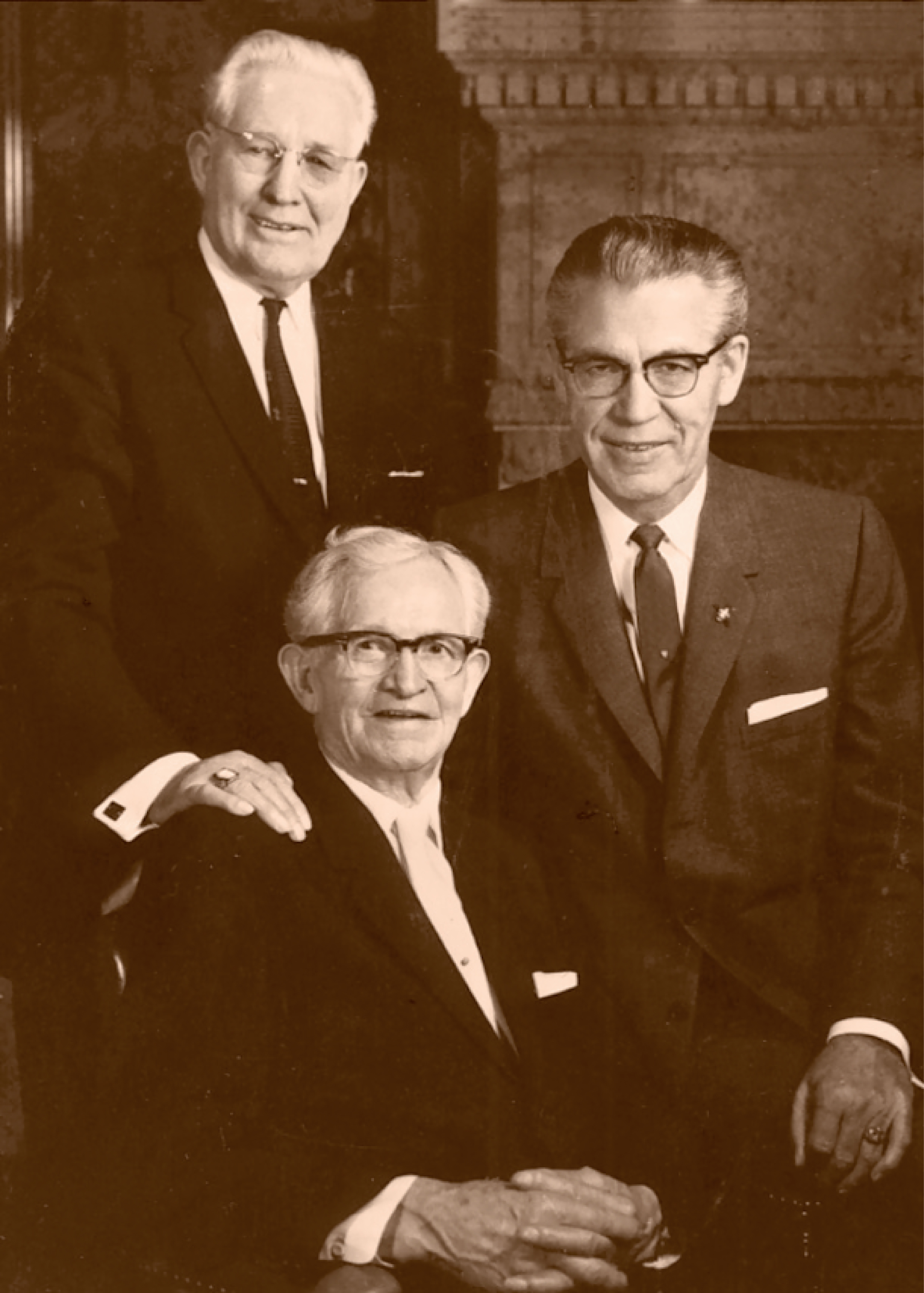 From 1963 to 1970, two
From 1963 to 1970, two
former Edmonton residents,
Hugh B. Brown (left) and
N. Eldon Tanner, were counselors
to David O. McKay in
the First Presidency. (Intellectual
Reserve, Inc.)
Conclusion
The three concepts referred to at the beginning of this Edmonton and northern Alberta chapter—those of sustained growth, the power of a knowledgeable testimony of the restored gospel, and the blessings of temple worship—have all become part of the Saints’ spiritual heritage in the Alberta region of Zion. The growth of the Church in Edmonton and northern Alberta has been remarkable since the Edmonton Branch was organized in 1935. Many people in Edmonton and northern Alberta have come from southern Alberta and elsewhere, and, with mission headquarters in Edmonton for many years, there has been a steady stream of convert baptisms. These factors have caused Church membership in the area to increase at a much higher rate than the general population. By 2015, more than twenty thousand Latter-day Saints resided within the Edmonton Temple District. Active and viable institute and young single adult programs continue to help young people develop knowledgeable testimonies. A growing leadership base augurs well for future Church growth. The Edmonton Alberta Temple is a symbol of the permanence and maturity of the Church in Edmonton and northern Alberta. The temple provides a reason for members, including those retired and preparing for retirement, to remain in an area where they can live in a strong gospel environment and enjoy the “crowning blessings” available for both the living and the dead.
Addendum
After this chapter had been written, the Sherwood Park Alberta Stake, a fifth Edmonton stake, was created on 9 April 2017, by realignment of the boundaries of the four existing stakes. Robert W. Mendenhall was sustained as stake president with J. Paul Kristensen and W. Darwin Laurie as counselors.
Notes
[1] Gordon B. Hinckley, “New Temples to Provide ‘Crowning Blessings’ of the Gospel,” Ensign, May 1998, 87–88.
[2] www.canada.distancesonline.com; “Alberta: Location and Land,” http://
[3] Rod Macleod, “Edmonton’s Story,” www.epl.ca.
[4] “Population of Census Metropolitan Areas,” Statistics Canada, www.statcan.gc.ca.
[5] “Economy,” City of Edmonton, www.edmonton.ca/
[6] Blair Bennett (former president of the Bonnie Doon Stake), interview by Walter C. Meyer, 20 January 2014.
[7] Ron Peterson (former counselor in Grande Prairie stake presidency), interview by Walter C. Meyer, 7 Feb 2014.
[8] Peterson interview, 7 February 2014.
[9] Jane McLean, “Average Canada Temperature by Month and City,” www.gocanada.about.com/
[10] Author’s personal experience in October 1969.
[11] Olive Wood Nielson, A Treasury of Edward J. Wood (Salt Lake City: Publishers Press, 1983), 294–95; William Cyrus Tolman, KWZF-3HV, familysearch.org.
[12] Wilbur Gordon Hackney, “History of the Western Canadian Mission” (master’s thesis, Brigham Young University, 1950), 53.
[13] Hackney, “Western Canadian Mission,” 62.
[14] John H. Blackmore to N. Eldon Tanner, 21 July 1947, original copy in Edmonton Branch General Minutes (hereafter EBGM), folder 6, between pages 96 and 97, Church History Library (hereafter CHL), LR 2515 11. John H. Blackmore was excommunicated from the Church in 1947 for advocating plural marriage.
[15] Lethbridge Stake, A History of the Mormon Church in Canada (Lethbridge, AB: Lethbridge Stake, 1967), 221.
[16] “Alberta History,” www.britannica.com; Lethbridge Stake, Mormon Church in Canada, 221.
[17] John A. Widtsoe to N. E. Tanner, 10 January 1947, copy in EBGM, folder 6, between pages 96 and 97, CHL, LR 2515 11; “History,” Dedication of Edmonton Chapel, 5 August 1951, CHL, M255.86 E24w.
[18] Vi A. Wood, interview by Charles Ursenbach, Edmonton, Alberta, 14 September 1973, 7, CHL, OH 201; Lethbridge Stake, Mormon Church in Canada, 222.
[19] John H. Sheppard (bishop of Calgary Ward) to Asael E. Palmer (president of the Lethbridge Stake), 8 September 1932, in Lethbridge Stake Stake President’s Files (hereafter LSSPF), box 1, folder 7, CHL, LR 1306 21; Dedication of Edmonton Chapel, 5 August 1951, folder 1, CHL, M255.86 E24w.
[20] Vi Wood, minutes of 26 February 1933, original copy in EBGM, folder 6, between pages 96 and 97, CHL, LR 2151 11. Others present included J. B. Merrill and her daughter Edith, Mirza Pack, J. V. Johansen, and two nonmembers (Ibid.). See also Vi A. Wood, oral history, 11, and “History of the Edmonton Branch,” EBGM, folder 4, 8, CHL, LR 2515 11; Alfred and Mabel Strate, “A Brief History of the Edmonton Branch,” n.d., EBGM, folder 6, between pages 96 and 97, CHL, LR 2515 11.
[21] Elmo E. Fletcher, Church Directory of Organizations and Leaders (hereafter CDOL), cdol.lds.org; V. A. Wood, The Alberta Temple (Calgary: Detseling Enterprises, 1989), 212.
[22] Alfred and Mabel Strate, “A Brief History of the Edmonton Branch,” EBGM, folder 6, between pages 96 and 97, CHL, LR 2515 11.
[23] “A History of the Edmonton Branch,” EBGM, folder 4, 9–10, CHL, LR 2515 11; G. Homer Durham, N. Eldon Tanner: His Life and Service (Salt Lake City: Deseret Book, 1982), 112; Lethbridge Stake, Mormon Church in Canada, 222.
[24] Durham, N. Eldon Tanner, 57.
[25] Durham, N. Eldon Tanner, 109–10; Calgary Ward Record of Members, Film 944, records #912–918, 953–55, CHL, CR 375 8. These records show that the Tanner and Low families’ membership records were transferred to the Calgary Ward (of which Edmonton was a dependent branch) in 1937.
[26] Durham, N. Eldon Tanner, 60–64, 69n9, 70–80, 102, 145–50; “Solon Earl Low,” Wikipedia, https://
[27] Edmonton Branch Manuscript History and Historical Reports (hereafter EBMHHR), CHL, LR 2515 2.
[28] Calgary Ward, Record of Members, film #944, CHL, CR 375 8.
[29] EBGM, folder 1a, 97, 9 October 1938, CHL, LR 2515 11.
[30] “History of the Edmonton Branch,” EBGM, folder 4, 29, CHL, LR 2515 11; “History,” Dedication Edmonton Chapel, 5 August 1951, CHL, M255.86 E24w; Lethbridge Stake, Mormon Church in Canada, 223.
[31] Asael E. Palmer to President Heber J. Grant and Counselors, 16 April 1935; Heber J. Grant and David O. McKay to Asael E. Palmer, 20 April 1935, LSSPF, box 1, folder 1, CHL, LR 1306 21.
[32] N. E. Tanner to David O. McKay, 26 October 1939, EBGM, folder 6, between pages 96 and 97, CHL, LR 2515 11; Asael E. Palmer to President Heber J. Grant and Counselors, 19 June 1940, LSSPF, box 1, folder 1, CHL, LR 1306 21.
[33] Hackney, “Western Canadian Mission,” 5.
[34] Hackney, “Western Canadian Mission,” 4.
[35] Hackney, “Western Canadian Mission,” 47–48.
[36] Hackney, “Western Canadian Mission,” 49, 61; Afton Ingersoll Miller obituary, Deseret News, 25–29 November 2012. The age of Afton Bromley Ingersoll is from the 1930 and 1940 US Census records, which establish her year of birth as 1921. The 1920 US Census for the family shows that she had not been born by that time.
[37] Hackney, “Western Canadian Mission,” 48.
[38] Edmonton District General Minutes (hereafter EDGM), folder 1, 4, and 6 December 1941, 3 January 1942, 9–10, 14, CHL, LR 14948 11.
[39] Walter Miller, Western Canadian Mission, 1941 Report, Canada Calgary Mission Manuscript History and Historical Reports (hereafter WCM, CCMMHHR), box 1, folder 1, CHL, LR 10539 2; see chart below with regard to changing mission boundaries.
[40] WCM, CCMMHHR, box 1, folder 1, 15 May 1942, CHL, LR 10539 2.
[41] Hackney, “Western Canadian Mission,” 62.
[42] Hackney, “Western Canadian Mission,” 134.
[43] Changes from 1960 to 1985 are documented in “The Canada Calgary Mission,” LDS Mission Network, http://
[44] Canada Edmonton Mission, Historical and Statistical Office Files (hereafter CEM, HSOF), consulted at #305, 8425, 51 Ave., Edmonton, 2014.
[45] Calculations from The Times Comprehensive Atlas of the World, 12th ed. (London: Collins Reference, 2007), 63, 67.
[46] EDGM, folder 1, 17 September–14 December 1941, 2–12, CHL, LR 14948 11.
[47] EDGM, folder 1, 3 January–27 December 1942, 14–52, CHL, LR 14948 11; Hackney, “Western Canadian Mission,” 53–64.
[48] EDGM, folder 1, 26 October 1941 and 18 November 1942, 4, 48, CHL, LR 14948; Lethbridge Stake, Mormon Church in Canada, 223; Edmonton Branch, Annual Genealogical Report, Form E, 1938–1948, years 1941–43, film 105369, Family History Library (hereafter FHL).
[49] WCM, CCMMHHR, box 1, folder 1, 2–3 December 1941, 14 January and 26 February 1942, CHL, LR 10539 2.
[50] Hackney, “Western Canadian Mission,” 139.
[51] E. Dale LeBaron, Glen G. Fisher: A Man to Match the Mountains (Edmonton: Fisher House Publishers, 1992), 55–91.
[52] Hackney, “Western Canadian Mission,” 137.
[53] Hackney, “Western Canadian Mission,” compiled from mission yearly summaries, 51, 64, 77, 86, 93, 131, 134, 145, 163. Units in Saskatchewan and Alberta were transferred to the mission in 1942.
[54] Lethbridge Stake, Mormon Church in Canada, 222.
[55] Lethbridge Stake, Mormon Church in Canada, 222.
[56] EBGM, folder 1a, 19 March 1939, 115–18, and branch council and branch presidency minutes, 19 March 1939–22 November 1942, 244–90, CHL, LR 2515 11; Edmonton Branch, Annual Genealogical Report, Form E, years 1938 to 1948, 105369, FHL.
[57] “President N. Eldon Tanner Dies,” Ensign, January 1983, 8; Durham, N. E. Tanner, dust jacket and 135.
[58] Stories heard by the author starting when he was a young man in the Calgary Stake.
[59] EBGM, folder 1a, 25 February 1941, 183–84, CHL, LR 2515 11.
[60] Edmonton Branch, Annual Genealogical Report, Form E, Years 1938 to 1948, baptism listings, 105369, FHL.
[61] Personal knowledge of author.
[62] Edmonton Branch, Annual Genealogical Report, Form E, years 1938 to 1948, statistics, 105369, FHL; Hackney, “Western Canadian Mission,” 93.
[63] City of Edmonton, “Population History,” www.edmonton.ca/
[64] Hackney, “Western Canadian Mission,” 162.
[65] “Population History,” City of Edmonton, www.edmonton.ca/
[66] “Polaris,” Edmonton Institute Yearbooks, 1957–58, 195859, 1959–60 and 1960–61; Hackney, “Western Canadian Mission,” 64, 77–78, 86, 93, 131, 135, 146, 163.
[67] DiAnn Merkley Hirsche (secretary of the Edmonton District Relief Society), interview by Walter Meyer, 13 March 2014; Hackney, “Western Canadian Mission,” 142; Lethbridge Stake, Mormon Church in Canada, 225–28.
[68] EBGM, folder 6, 42, and folder 5, 139, 188, CHL, LR 2515 11.
[69] “Building for the Future,” Dedication of Edmonton Chapel, 5 August 1951, CHL, M255.86 E24w; Lethbridge Stake, Mormon Church in Canada, 226.
[70] Edmonton Alberta Millwoods Stake Sesquicentennial Committee, Tribute to the Pioneers of the Church in Edmonton (1980; hereafter Millwoods Tribute), 15.
[71] EBGM, folder 7, 23 April and 3 September 1950, 83 and 131, CHL, LR 2515 11.
[72] Dedication Edmonton Chapel, 5 August 1951, CHL, M255.86 E24w; Lethbridge Stake, Mormon Church in Canada, 226.
[73] EBGM, folder 1a, 19 March 1939, CHL, LR 2515 11; Durham, N. Eldon Tanner, 141.
[74] Hattie Baker Jensen, as told to her daughter Maureen Jensen Woolf, Hattie Baker Jensen: My Life Story (Houston: D. Armstrong, 1989), 124–26.
[75] Millwoods Tribute, 9.
[76] Phyllip G. Redd, “A History of Formal Religious Instruction by The Church of Jesus Christ of Latter-day Saints in Alberta, 1890–1960” (master’s thesis, Brigham Young University, 1961), 51, CHL, M277.123 R313h.
[77] Redd, “Formal Religious Instruction,” 51–52.
[78] Drew Walters (institute director in 2014), email correspondence with Walter Meyer, March 2014, attachment, “The Edmonton Institute of Religion,” (4 pp.), from “Institutes of Religion in Western Canada.”
[79] Redd, “Formal Religious Instruction,” 52.
[80] Redd, “Formal Religious Instruction,” 54–55.
[81] Redd, “Formal Religious Instruction,” 56; Walters Correspondence, March 2014.
[82] Redd, “Formal Religious Instruction,” 57.
[83] “Polaris,” Edmonton Institute Yearbooks, 1957–58, 1958–59, 1959–60 and 1960–61.
[84] Moroni M. Larson, “Travels and Experiences of the Mission President,” 31 March 1956, WCM, CCMMHHR, box 1, vol. 2, folder 1, CHL, LR 10539 2.
[85] Moroni M. Larson, “Travels and Experiences of the Mission President,” 31 March 1956, WCM, CCMMHHR, box 1, vol. 2, folder 1, CHL, LR 10539 2.
[86] Walters Correspondence, March 2014.
[87] Walters Correspondence, March 2014.
[88] Redd, “Formal Religious Instruction,” 60.
[89] Walters Correspondence, March 2014.
[90] Gail Dubyk (senior support specialist Canada area of Seminaries and Institutes), email correspondence with Walter Meyer, 10 June 2014.
[91] Author’s personal records.
[92] Personal knowledge of author.
[93] WCM, CCMMHHR, box 1, vol. 2, folder 1, 6 December 1953, CHL, LR 10539 2.
[94] Heber G. Jensen, interview by Charles Ursenbach, 1975, 15, 17, CHL, OH 235.
[95] Leroy Rollins, interview by Charles Ursenbach, Edmonton, Alberta, 1976, 30, CHL, OH 307.
[96] Heber G. Jensen, interview by Charles Ursenbach, 1975, 15, 17, CHL, OH 235.
[97] Lethbridge Stake, Mormon Church in Canada, 227.
[98] WCM, CCMMHHR, box 1, vol. 2, folder 1, 5 July 1953, CHL, LR 10539 2.
[99] WCM, CCMMHHR, box 1, vol. 2, folder 2, 10 May 1959, CHL, LR 10539 2.
[100] Lethbridge Stake, Mormon Church in Canada, 227–28.
[101] Matthew Edwards (Red Deer Stake Clerk), email correspondence with Walter Meyer, 7, 13 May and 15 June 2014.
[102] Edwards Correspondence, 7, 13 May and, 15 June 2014.
[103] Red Deer Branch Sunday School Minutes and Records, 4 January 1942, CHL, LR 7365 15.
[104] Red Deer Branch MHHR, 11 November 1951, 29 November 1953, 15 and 29 November 1960, CHL, LR 7365 2; Edwards Correspondence, 7, 13 May and 15 June 2014.
[105] Red Deer Branch MHHR, 16 April 1961, 2 August 1964, CHL, LR 7365 2; Edwards Correspondence, 7, 13 May and, 15 June 2014.
[106] Leroy Rollins, interview by Charles Ursenbach, 1976, 31, CHL, OH 307; Leroy Rollins, Experiences and Episodes, private publication (1997), 69.
[107] Rollins, Experiences, 79.
[108] Deseret News 2012 Church Almanac, 443.
[109] Rollins, Experiences, 80.
[110] Edmonton Stake Manuscript History and Historical Reports (hereafter ESMHHR), 1960, CHL, LR 2516 2;
[111] LDS Church Member and Statistical Records Division, correspondence with Walter Meyer, 17 March 2014.
[112] “Population History,” The City of Edmonton, www.edmonton.ca/
[113] Rollins, Experiences, 72, 81.
[114] Leroy Rollins, “My Call and Experiences as Edmonton’s first Stake President,” in Northern Light: A Compilation of Inspirational Stories from Members of the Edmonton Alberta Bonnie Doon Stake (Priority Printing, 1999), 1; Rollins, Experiences, 73.
[115] Eugene E. Campbell and Richard D. Poll, Hugh B. Brown, His Life and Thought (Salt Lake City: Bookcraft, 1975), 217.
[116] Rollins, Experiences, 84.
[117] Author’s personal recollection.
[118] ESMHHR, 14 January and 27 March 1963, CHL, LR 2516 2.
[119] Warren D. Wilde, “Edmonton Alberta Stake from April 22, 1972, to June 27, 1981,” in Millwoods Tribute, 50; Historical Information for Lloydminster, Barrhead, Cherry Grove, Rimbey, Stettler, and Wetaskiwin, cdol.lds.org; ESMHHR, folder 1, CHL, LR 2516 2.
[120] Record in possession of Gwen Payne Meyer.
[121] Hirsche Interview, 13 March 2014.
[122] Hattie Baker Jensen, My Life Story, 124.
[123] Heber G. Jensen, interview by Charles Ursenbach, 1975, 15, 17, CHL, OH 235; Hattie Baker Jensen, My Life Story, 277–307; Wood, Alberta Temple, 212.
[124] LeRoy Rollins, personal conversation with Walter Meyer, 13 November 2013.
[125] CCMMHHR, box 2, vol. 4, folder 2, October 1969, CHL, LR 10539 2.
[126] Millwoods Tribute, 36.
[127] Jeannie Takahashi, in Millwoods Tribute, 35–36.
[128] ESMHHR, folder 1, 3 November 1974, CHL, LR 2516 2.
[129] Warren Wilde (second Edmonton Stake president), interview by Walter Meyer, 20 January 2014.
[130] Wilde Interview, 20 January 2014.
[131] Rhoda H. Hampton, “The Contaminated Chocolates,” New Era, December 1979, 28–29.
[132] ESMHHR, 3–4 February 1973, CHL, LR 2615 2.
[133] Wilde Interview, 20 January 2014.
[134] Wilde Interview, 20 January 2014.
[135] ESMHHR, 29 July 1973 and 3 November 1974, CHL, LR 2516 2; Stettler Branch General Minutes, CHL, LR 8703 11.
[136] Information in chart from ESMHHR, 3 November 1974, CHL, LR 2516 2; Stettler Branch General Minutes, 13, 20 April and 18 May 1975, CHL, LR 8703 11.
[137] ESMHHR, 3 November 1974, CHL, LR 2516 2.
[138] “900 Participate in Canadian Solemn Session,” Church News, 9 August 1975, 10.
[139] Millwoods Tribute, 73; Northern Light, 6.
[140] Chester Horton, “History of Grande Prairie Branch,” manuscript attached to correspondence of LeRon Woolley (Grande Prairie Stake patriarch) with Walter Meyer, spring 2014.
[141] Horton, “History of Grande Prairie Branch”; Philip Proctor, interviewed by Walter Meyer, 8 January 2014.
[142] Parley A. Arave, “Another Immediate Healing,” Church Historian’s Copy, CHL, MS 3613; Proctor interview, 8 January 2014.
[143] CCMMHHR, box 2, vol. 3, folder 2, 24 March 1963, CHL, LR 10539 2.
[144] Peace River District MHHR, 12 April 1964, CHL, LR 6816 2; Hudson’s Hope Branch Historical Information, CDOL, cdol.lds.org.
[145] Proctor interview, 8 January 2014.
[146] LaRon Woolley, email correspondence with Walter Meyer, 13, 16, 17 May, and 1 June 2014.
[147] Proctor interview, 8 January 2014.
[148] Proctor interview, 8 January 2014.
[149] cdol.lds.org.
[150] Peace River District MHHR, 13 September 1987, CHL, LR 6816 2.
[151] Grande Prairie Alberta Stake Historical Information, cdol.lds.org.
[152] Warren Wilde, “Edmonton Alberta Stake from April 22, 1972 to June 27, 1981,” Millwoods Tribute, 56–57, 59; Wilde interview, 20 January 2014.
[153] Edwards Correspondence, 7, 13 May, 15 June 2014; David Henderson (former president of the Bonnie Doon Stake), conversation with Walter Meyer, 17 January 2014.
[154] ESMHHR, folder 1, 5 July 1973, CHL, LR 2516 2.
[155] Personal knowledge of author.
[156] Personal knowledge of author.
[157] Personal knowledge of author.
[158] Northern Light, 6; Millwoods Tribute, 76; Bryant Stringham, interview by Walter Meyer, 21 January 2014.
[159] Stringham interview, 21 January 2014; Millwoods Tribute, 76.
[160] Stringham interview, 21 January 2014.
[161] Don Sommerfeldt (former president of Millwoods Stake), interview by Walter Meyer, 4 March 2014; Wilde Interview, 20 January 2014.
[162] Wilde, Millwoods Tribute, 64.
[163] Hackney, “Western Canadian Mission,” 142; Mormon Church in Canada, 226.
[164] Rollins conversations, 13 November 2013.
[165] Personal knowledge of author.
[166] Personal knowledge of author.
[167] Personal knowledge of author.
[168] Personal knowledge of author.
[169] Lethbridge Stake, Mormon Church in Canada, 236.
[170] David Dorward, MLA; Cathryn Landreth, Assistant Deputy Minister; and Cecil Purves, former Mayor of Edmonton, conversations with Walter C. Meyer.
[171] Conversations with Cecil Purves.
[172] Don Salmon, Blair Bennett, and Don Sommerfeldt (former stake presidents), interview by Walter C. Meyer, 13, 20 January, 4 March 2014.
[173] Edmonton Alberta North Stake Historical Information, cdol.lds.org.
[174] Stake History Interview, 20 August 2013, Edmonton Alberta North Stake Annual Historical Reports, folder 2013, CHL, LR 378089 3.
[175] Millwoods Tribute (see full citation in note 70).
[176] Northern Light (see full citation in note 114).
[177] Observation of Walter C. Meyer, 18 January 2017.
[178] Donald D. Salmon (first president of the Riverbend Stake), interview by Walter Meyer, 13 January 2014.
[179] David Henderson (former president of the Bonnie Doon Stake), conversations with Walter Meyer, 17 January 2014; Edmonton Alberta Millwoods Stake Annual Historical Reports, box 1, 1998, LR 516457 3, CHL.
[180] Deseret News 2012 Church Almanac, 235.
[181] Personal knowledge of author.
[182] CEM, HSOF.
[183] CEM, HSOF.
[184] CEM, HSOF.
[185] “Fire devastates Slave Lake,” Church News, 19 May 2011, 2.
[186] Emily Mertz, “Top 10 Most Costly Disasters in Canadian History for Insurers,” Global News, updated 7 July 2016, globalnews.ca/
[187] Tod Beaulne, email and telephone correspondence with Walter Meyer, January 2017; “2016 Fort McMurray Wildfire,” https://
[188] “2016 Fort McMurray Wildfire.” Two people, however, were killed in a car accident during the evacuation.
[189] Tod Beaulne, correspondence with Walter Meyer.
[190] Tod Beaulne, correspondence with Walter Meyer.
[191] “Devastating Wildfire Provides Opportunity for Service,” 15 May 2016, www.mormonnewsroom.ca.
[192] Calculated from year-end statistic of the six stakes in temple district.
[193] “Population History,” City of Edmonton, https://
[194] LDS Church Member and Statistical Records Division, correspondence with Walter Meyer, 17 March 2015; calculated from 2013 year-end statistics of the six stakes in temple district.
[195] Personal knowledge of author.
[196] Correspondence of Walter C. Meyer with the six stake presidents and clerks, January 2015.
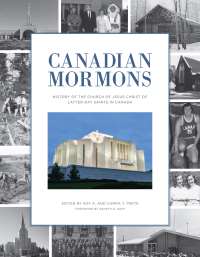
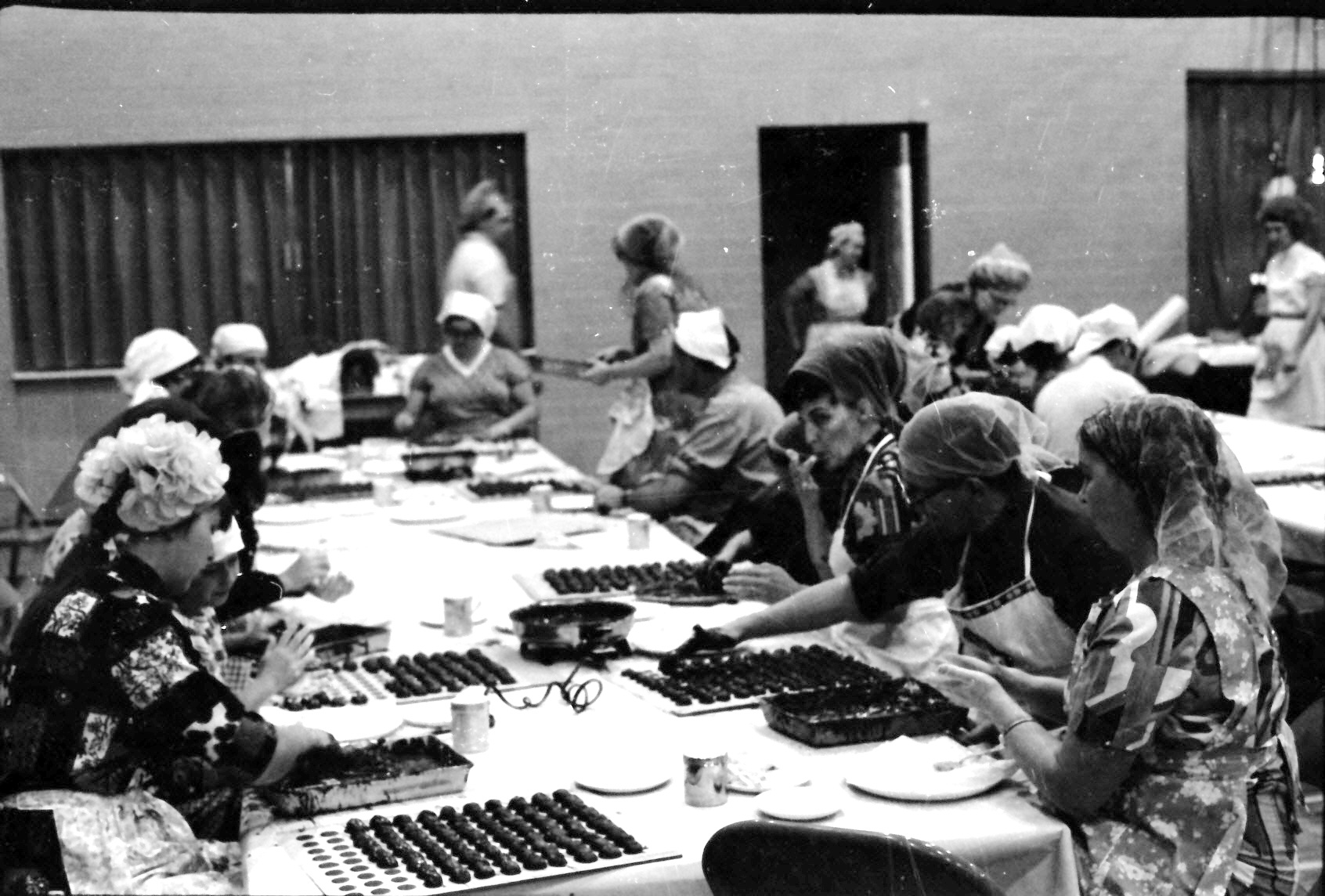 Chocolate making was a successful fund-raising project for members in the Edmonton area for many years. It required significant teamwork and specialized skills, especially in rolling and dipping the chocolates. (Walter Meyer)
Chocolate making was a successful fund-raising project for members in the Edmonton area for many years. It required significant teamwork and specialized skills, especially in rolling and dipping the chocolates. (Walter Meyer)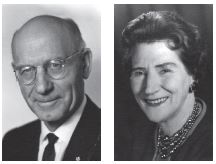 Heber and Hattie Jensen were a complementary team in their service to the Lord. (Maureen Woolf)
Heber and Hattie Jensen were a complementary team in their service to the Lord. (Maureen Woolf)